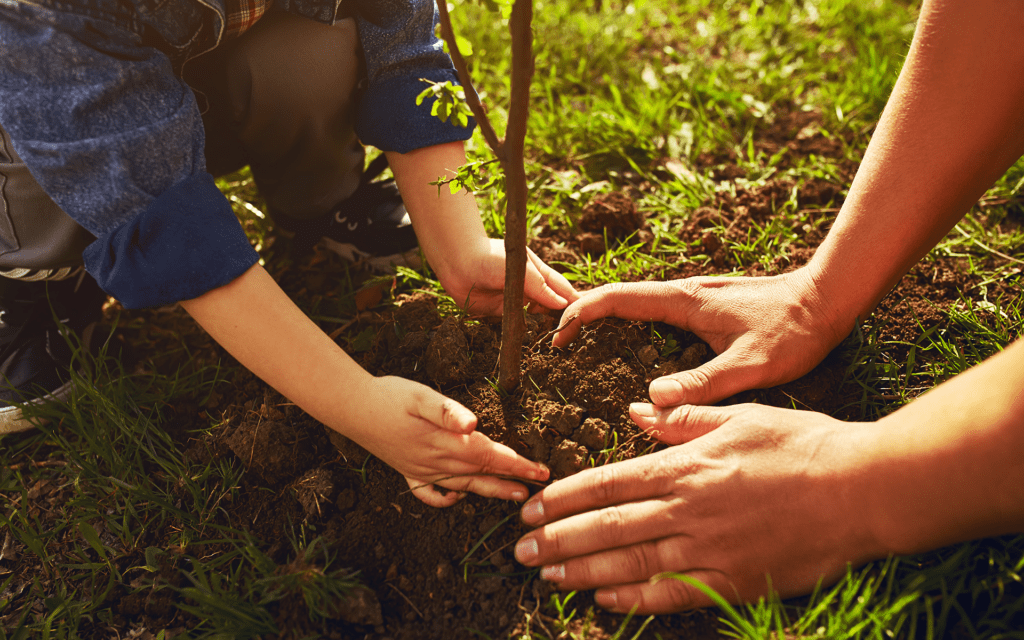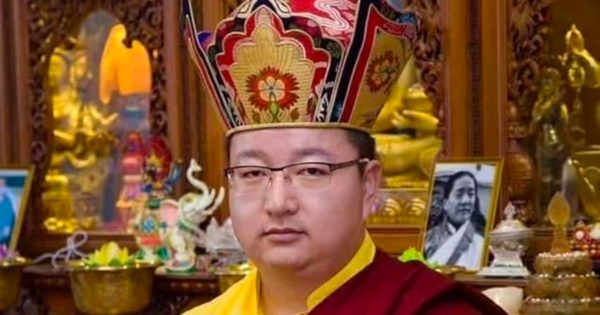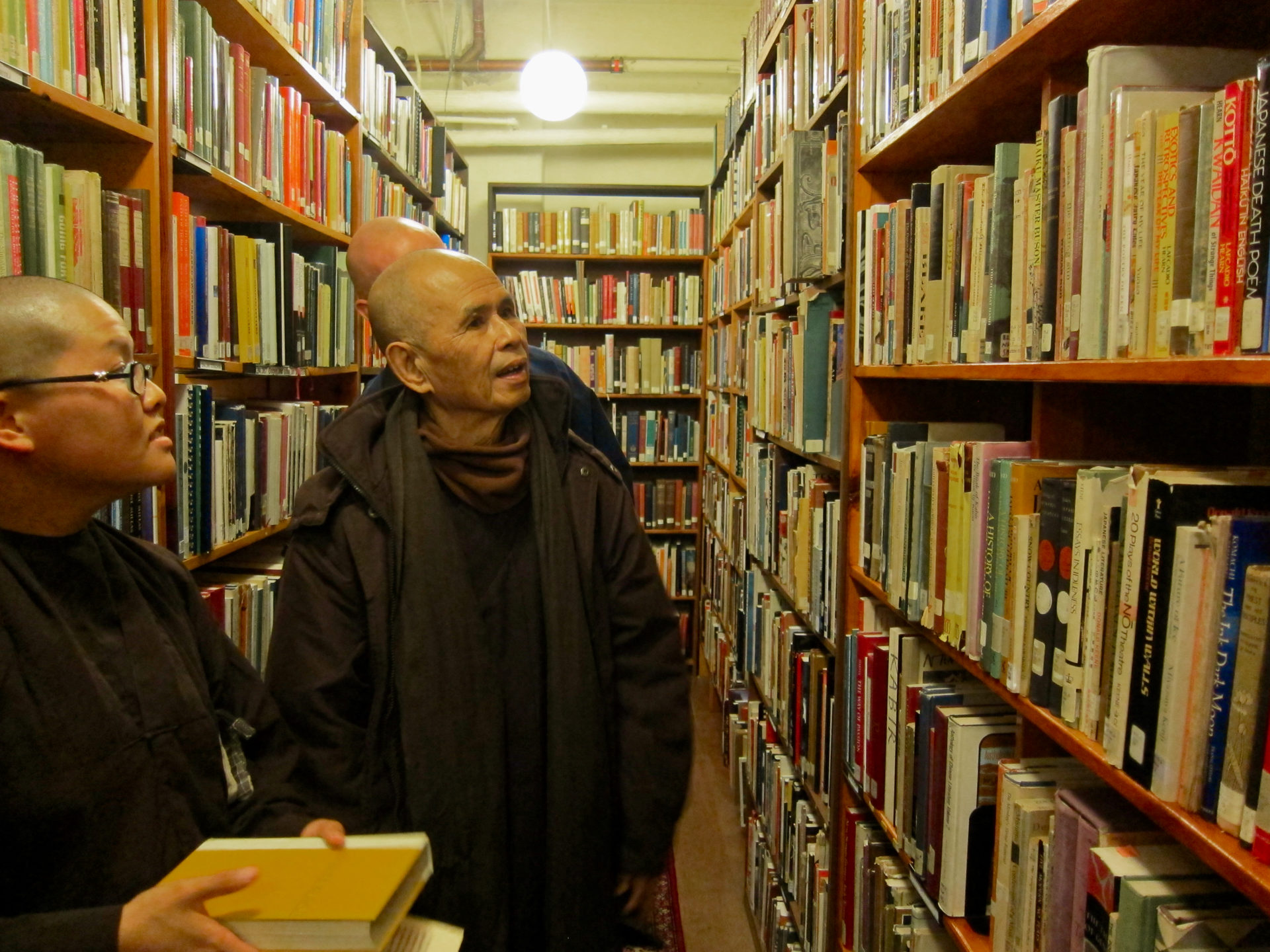Buddhist practice and worldly obstacles — we all have them, but how do you overcome and purify negativities? Advice from Dalai Lama, Garchen Rinpoche and others.
Obstacles are plentiful in daily life. Whether we’re dealing with an emergency with our children, rushing around trying to find an emergency plumber, dealing with the aftermath of an accident — or even something more terrible, such as a...
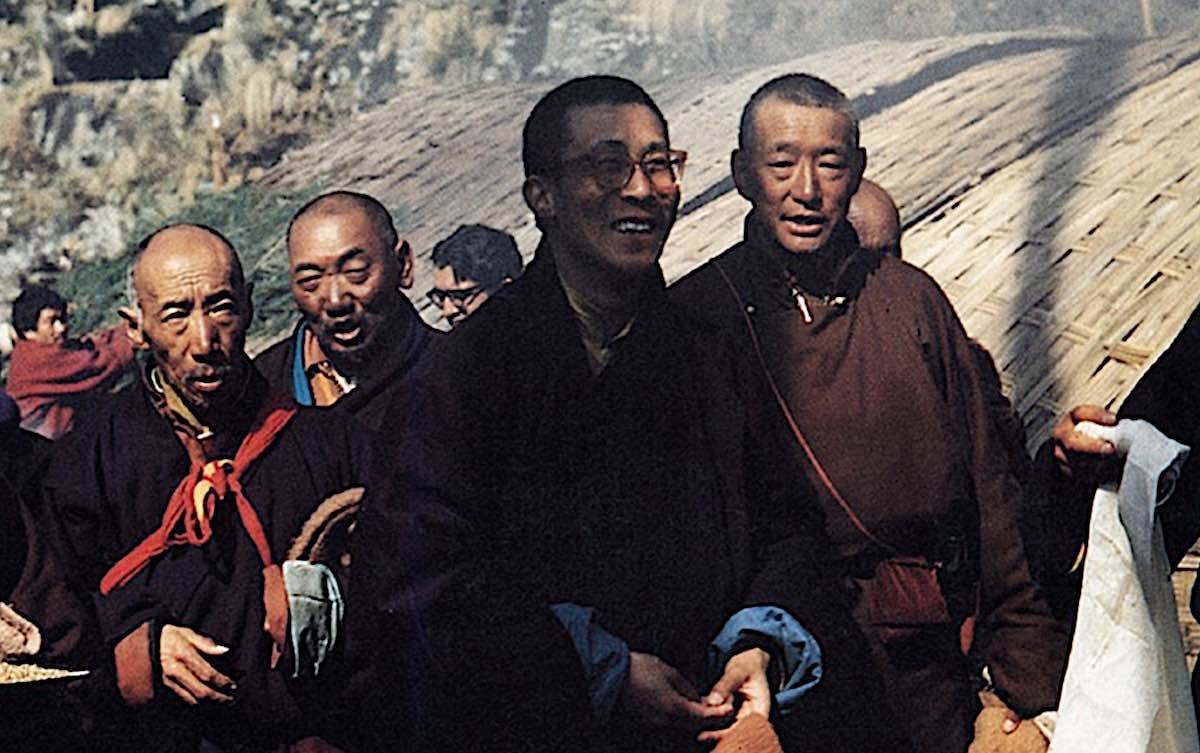
Obstacles are plentiful in daily life. Whether we’re dealing with an emergency with our children, rushing around trying to find an emergency plumber, dealing with the aftermath of an accident — or even something more terrible, such as a natural disaster or war. Yes, we can find refuge in Buddha, Dharma and Sangha. Yes, we can rely on the Dharma for answers. Yes, we can trust that “karma-willing” there will be Bodhisattvas in our life. Yet, sometimes it feels as if there are so many crushing obstacles, tragedies, and disasters that it all seems negative and impossible.
The Dalai Lama, who faced greater obstacles and dangers than most of us will — including invasion, persecution, and exile — often speaks about obstacles and how they can be transformed into opportunities to practice: “It is under the greatest adversity that there exists the greatest potential for doing good, both for oneself and others.”
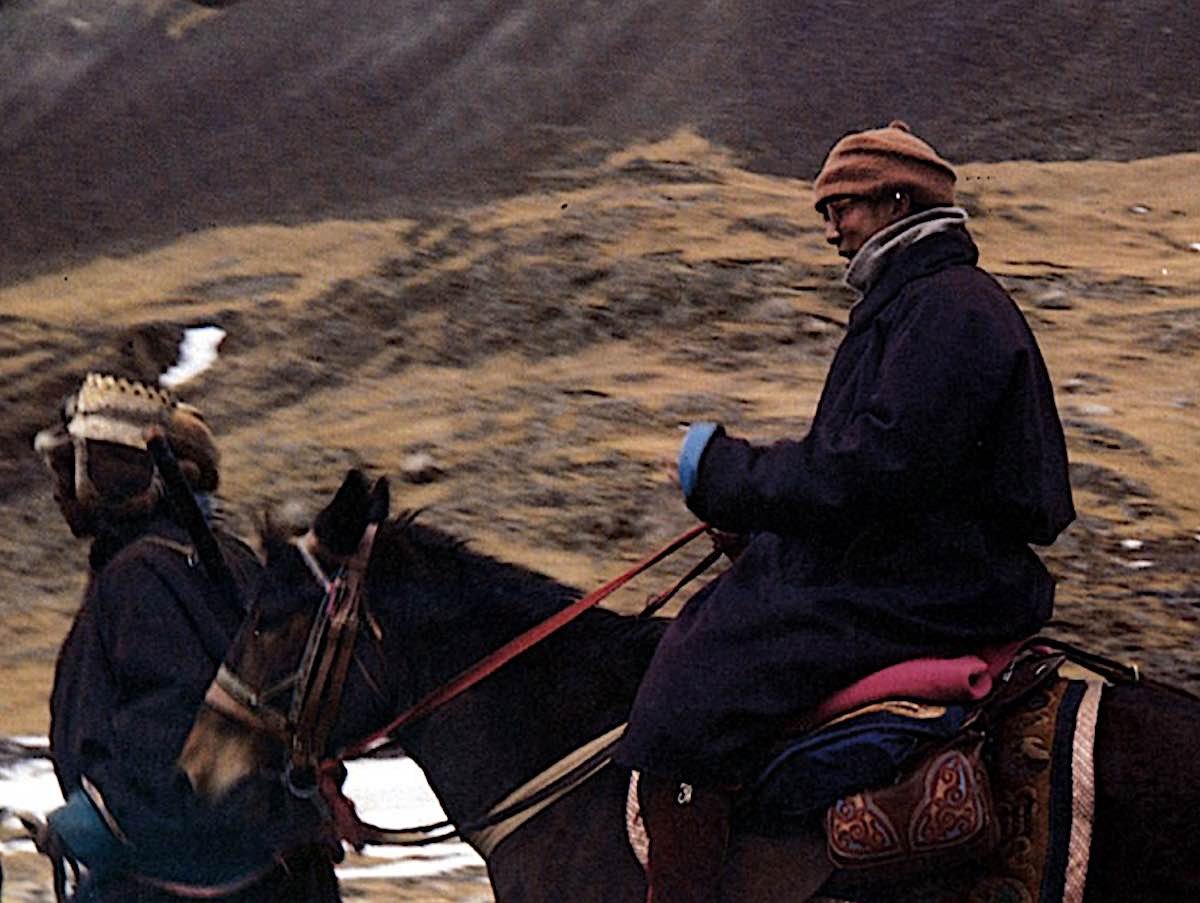 The Dalai Lama on horseback in 1959 overcame the obstacle of persecution and exile.
The Dalai Lama on horseback in 1959 overcame the obstacle of persecution and exile.
The shining example: His Holiness the 14th Dalai Lama
When this happens, it can be helpful to remember the shining example of His Holiness the 14th Dalai Lama and his people who fled into exile when faced with oppression and violence. In the face of that disaster — and after overcoming it through years of obstacles — His Holiness remains the perfect model of Compassion and Metta. [See the photos below of His Holiness in 1959, enduring the long march to India.]
On the first anniversary after exile, his Holiness said: “As to the future, I stated my belief that, with truth, justice and courage as our weapons, we Tibetans would eventually prevail in regaining freedom for Tibet”
Video teaching below from His Holiness, speaking on “Facing Challenges with compassion and wisdom”:
Kyabje Garchen Rinpoche has very good starting advice on obstacles:
“All these negativities, all the difficulties we now experience in the world, are really overcome if we cultivate a mind of love and compassion.”
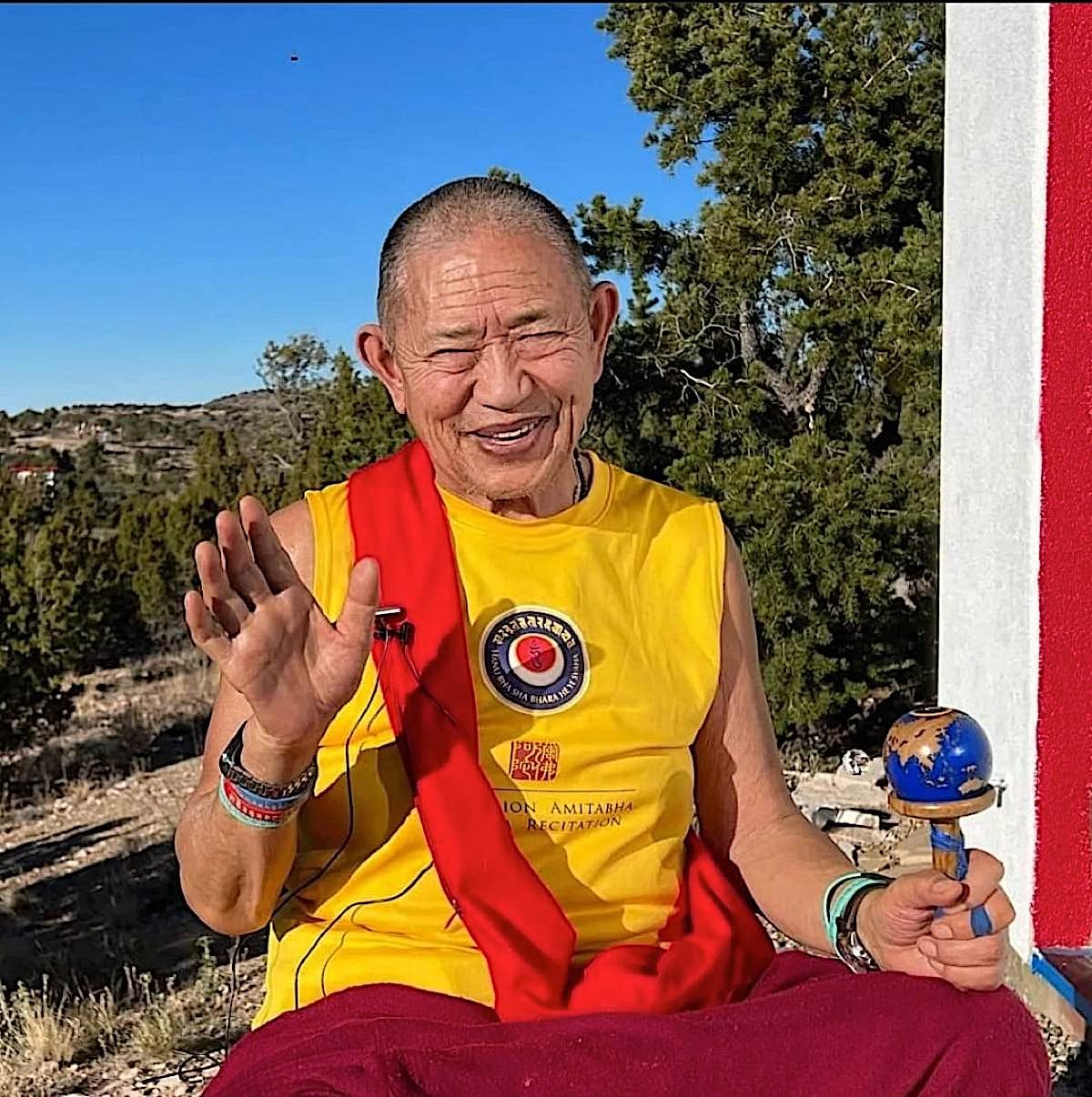 His Eminence Garchen Rinpoche with a Globe World Peace Prayer Wheel from Holy Land Prayer Wheels. Garchen Rinpoche discusses karma and obstacles in many teachings. Generating merit with Dharma practice is one method for overcoming negative karmas — both our own and our collective societal negative karmas — that can help us overcome obstacles. [See the video below with his talk on the Coronoa Virus (and other world events) as obstacles.] Prayer Wheels are certainly one method of creating merit — visualizing the virtues of the mantras going out to all sentient beings. The World Peace prayer wheel concept was a project of Holy Land Prayer Wheels. [For a feature on this, see>>]
His Eminence Garchen Rinpoche with a Globe World Peace Prayer Wheel from Holy Land Prayer Wheels. Garchen Rinpoche discusses karma and obstacles in many teachings. Generating merit with Dharma practice is one method for overcoming negative karmas — both our own and our collective societal negative karmas — that can help us overcome obstacles. [See the video below with his talk on the Coronoa Virus (and other world events) as obstacles.] Prayer Wheels are certainly one method of creating merit — visualizing the virtues of the mantras going out to all sentient beings. The World Peace prayer wheel concept was a project of Holy Land Prayer Wheels. [For a feature on this, see>>]Obstacles are opportunities
No matter how great our examples of courage in the face of disasters, sometimes, our mental and emotional lives take such hits — facing challenges such as anxiety, depression, addiction, or grief — that love and compassion seems far away. How do we cope in these urgent situations? How do we prevent the tragedies and suffering from overwhelming our lives and our Buddhist practice?
From a Buddhist perspective, obstacles — even the most terrible and tragic — are opportunities to practice. If we face disaster, we help others as a compassionate practice. If we face seemingly insurmountable odds, somehow we adapt and overcome. These are not tests, they’re opportunities for merit, for compassionate practice, and for metta (loving-kindness practice.) Fortunately, there are Buddhist practices and supports to help us overcome even the worst obstacles, even war and natural disasters.
While some may be tempted, in the face of disaster to give up practicing, it can be inspiring to look back at all the deadly obstacles Buddhist monks, Siddhas and Yogis faced over the last two thousand years. In the inspiring example of the Dalai Lama, the tragedy and obstacle of invasion and exile became a blessing for others as the Dalai Lama’s teachings propagated around the world. The Dalai Lama said,
“When we meet real tragedy in life, we can react in two ways – either by losing hope and falling into self-destructive habits, or by using the challenge to find our inner strength.” — Dalai Lama
In separate teaching, he explained that we do not overcome opportunities through passive acceptance. “It is natural that we face obstacles in pursuit of our goals. But if we remain passive, making no effort to solve the problems we meet, conflicts will arise and hindrances will grow. Transforming these obstacles into opportunities is a challenge to our human ingenuity.”
There is no such thing as insurmountable obstacles in Buddhist philosophy. Just think of what it must have taken hundreds of years ago to build this meditation room at the Tiger’s Nest:
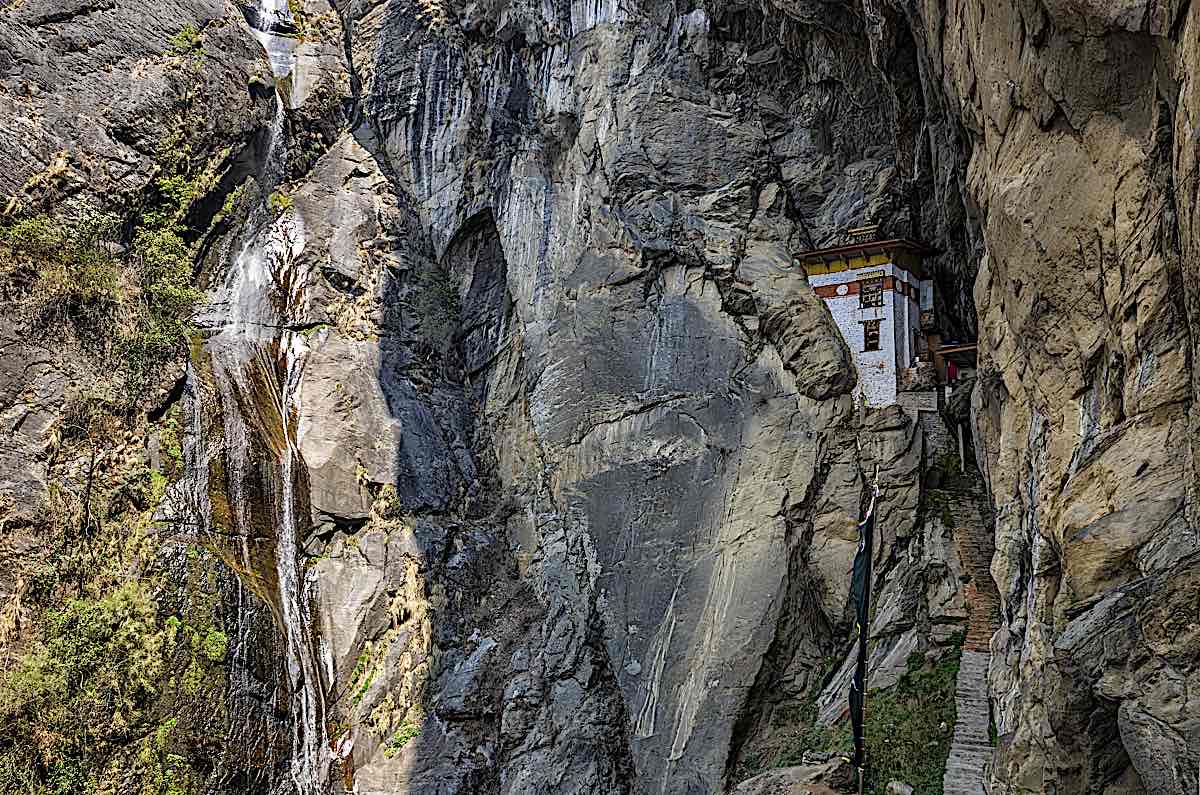 Khando Yeshi Tsogyal built a meditation room in a cave on an insurmountable rockface — just to undertake precious Vajrakilaya practice. Just think of how difficult it would be to build the steps, then haul the building materials, in the face of sheer cliffs, weather and other obstacles. Was the activity of overcoming the obstacle a practice of Vajrakilaya, or did Vajrakilaya help overcome? This is at the famous Tiger’s Nest Takshang Monastery in Bhutan.
Khando Yeshi Tsogyal built a meditation room in a cave on an insurmountable rockface — just to undertake precious Vajrakilaya practice. Just think of how difficult it would be to build the steps, then haul the building materials, in the face of sheer cliffs, weather and other obstacles. Was the activity of overcoming the obstacle a practice of Vajrakilaya, or did Vajrakilaya help overcome? This is at the famous Tiger’s Nest Takshang Monastery in Bhutan.
Obstacles: quick fixes
Some of the solutions we’ll cover in this feature include both Mahayana Sutra practices and Vajrayana. Before we do, glance at our “quick start fix list” for practice suggestions we’ve covered previously. If you’re still experiencing obstacles to life and practice, read the additional recommendations below. [8000 words of suggestions!]
Quick start fix list
Metta and Karuna (love and compassion) practices [See our previous feature on Metta and Karuna>>] Renewing refuge in the Three Jewels: Buddha, Dharma and Sangha [See our previous feature on Taking Refuge>>] Re-taking the lay vows, and especially focusing on daily conduct: “vow to not harm others”; “vow to undertake virtuous deeds”; and “service to others.” Reciting sutras — purifies many negative karmas and accumulates merit. [For a feature on reciting sutras, see>>] Vajrasattva purification practices. [Vajrasattva practice>> or see the embedded Vajrasattva video with a guided meditation in this feature below.] Prayer Wheel practice — recommended strongly by Garchen Rinpoche as a complete daily practice as it combines all of the practices of purifying “body, speech, and mind” and is a compassion (karuna) and loving-kindness (metta) aspirational practice. [See our previous feature on prayer wheel practice>>]If you find the obstacles are more urgent, devasting or unyielding even in the face of the short list above, read on for our more in-depth suggestions based on various teachers, sutras and tantras.
Obstacles as a sign of “progress”
In Buddhism, it’s said that difficulties are a sign of progress. Why? Because they offer us an opportunity to purify negativities and obscurations, and to cultivate positive qualities such as patience, compassion, and wisdom. They also tend to motivate us to practice more — there’s nothing like a “close call” for teaching us a Dharma lesson.
In Mahayana Buddhism, generally, reciting sutras or engaging in meritorious practices — such as generosity — are the “go-to” recommendations. Creating merit and virtue helps us overcome the negative karma (not only our own, but our collective negative karma as custodians of the Earth) but this is a gradual effect. There are some more “immediate” helpful practices, such as appealing to the Bodhisattvas for help. Guan Shi Yin or Avalokiteshvara, the Bodhisattva of Compassion, is famous for rescuing beings from harm with literally millions of accounts of direct interventions. For healing we might pray for help from Medicine Buddha or recite his precious sutra (see below).
Reciting the Medicine Buddha Sutra by Jason Espada with meditational images:
Reciting sutras — especially the Heart Sutra or the Diamon Sutra — are also considered protective and meritorious. Reciting Chapter 25 of the Lotus Sutra is famous for helping “avert war and strife” for example.
See our previous feature Guan Shi Yin and the ten great protections of the Goddess of Mercy>> Medicine Buddha Sutra: video audio recitation of full Sutta — listening or reciting is a very empowering healing practice If you have time for only one Buddhist Practice — recite Diamond Sutra, or Vajra Cutter Sutra; containing the four main points of Mahayana practice — unlimited merit according to many teachers: full text of the Sutra Why Reciting Buddhist Sutras Out Loud is Important; Sutras Help Us Remain Mindful of the Teachings and Disengage the “Clinging” Conscious Mind Pacifier of War and Strife, Avalokiteshvara Guanyin Chenrezig — Bodhisattva delivering us from every danger; Chapter 25 Lotus SutraVajrayana emphasizes actively working with obstacles
The Vajrayana tradition of Buddhism, on the other hand, emphasizes the importance of working with negativities and obscurations. In this tradition, it’s believed that when we encounter difficulties, we have an opportunity to purify our negativities and obscurations. This process of purification can lead to deeper insight, understanding, and compassion.
The Praises to 21 Taras and Tara’s mantra are the most often recommended practices for overcoming obstacles. Many Tibetan masters recount stories of Her rescues:
“On the inner level, you might have health problems, discomfort, insomnia, long and involved dreams, and other unusual phenomena,” explains Khenchen Palden Sherab Rinpoche and Khenpo Tsewang Dongyal Rinpoche in The Dark Red Amulet from Shambala. “The secret signs show up in the emotions. You may have more expectations and anxiety about the teachings. You may have doubts about the teacher and other sangha members, less certainty about what you are doing, or less compassion than before. These signs do not mean that you are losing the ability to love and be kind. When we come to these rough places in the road, we should always persevere, strengthen our practice, and keep moving toward our goal.” [1]
Vajrakilaya’s mantra chanted beautifully with meditational images. His mantra is famous for overcoming our obstacles:
Obstacles are opportunities
So next time you’re facing an obstacle, remember that it’s an opportunity to grow and learn. Work with the negativities and obscurations that arise, and cultivate positive qualities such as patience, compassion, and wisdom. In this feature, we’ll explore some ways to not only use our obstacles as a practice but also to prevent or overcome them.
Easy to say, perhaps. Aside from general stress and suffering for those around us, it is dispiriting in the context of maintaining Dharma practice. When things are difficult, it’s human nature to either search for solutions — including spiritual ones — or to throw up your hands in despair.
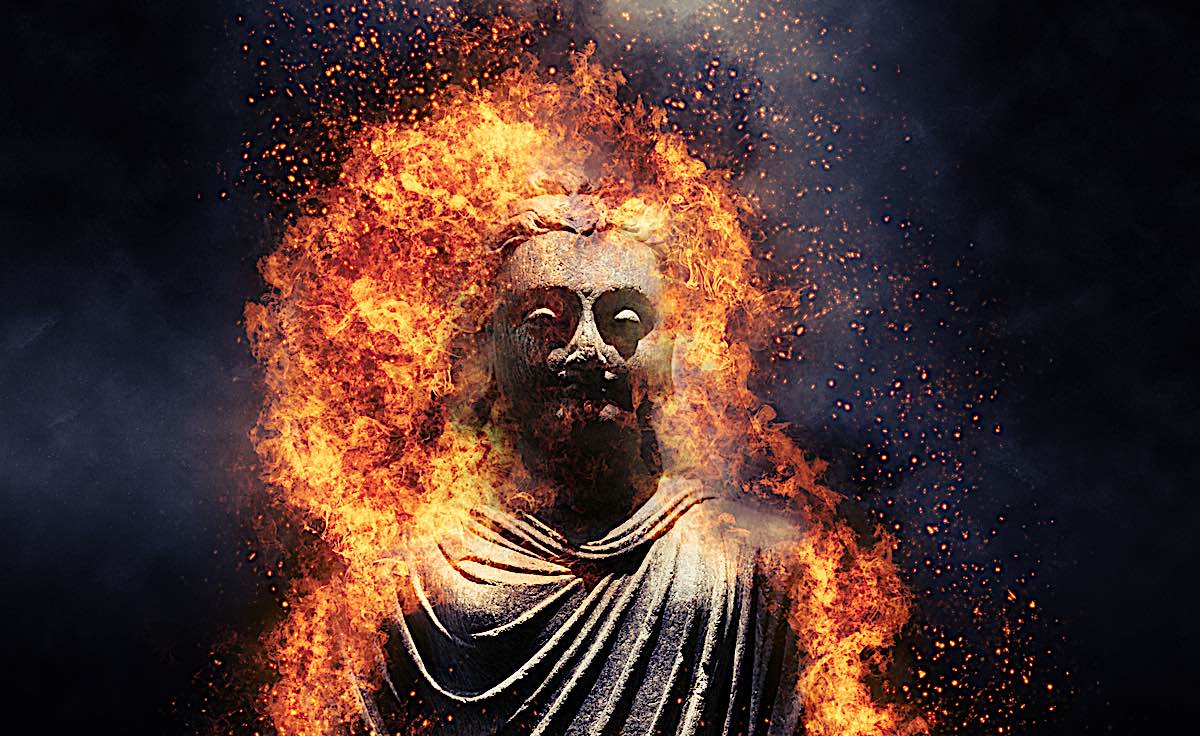 Does it feel like the obstacles of everyday life are so difficult it destroys our will to practice? Embrace the wisdom fire of Buddha Dharma to find the strength to continue.
Does it feel like the obstacles of everyday life are so difficult it destroys our will to practice? Embrace the wisdom fire of Buddha Dharma to find the strength to continue.Of course, as Mahayana Dharma practitioners, our obligation is to search for solutions for suffering — not only our own, but the suffering of all sentient beings. And, fortunately, Buddha, and all the great teachers since, have provided many solutions to our obstacles — not only how to prevent or overcome them, but also how to work with them as practice.
This always starts with helping ourselves. Saving ourselves in the face of an emergency makes sense since we can hardly save others from drowning if we’re underwater ourselves. (A recurring theme in Buddha’s Jataka Tales of his previous lives. Or, as a modern metaphor, in the event of an emergency, a flight attendant reminds us to place the oxygen mask on ourselves before we try to help our children or others.)
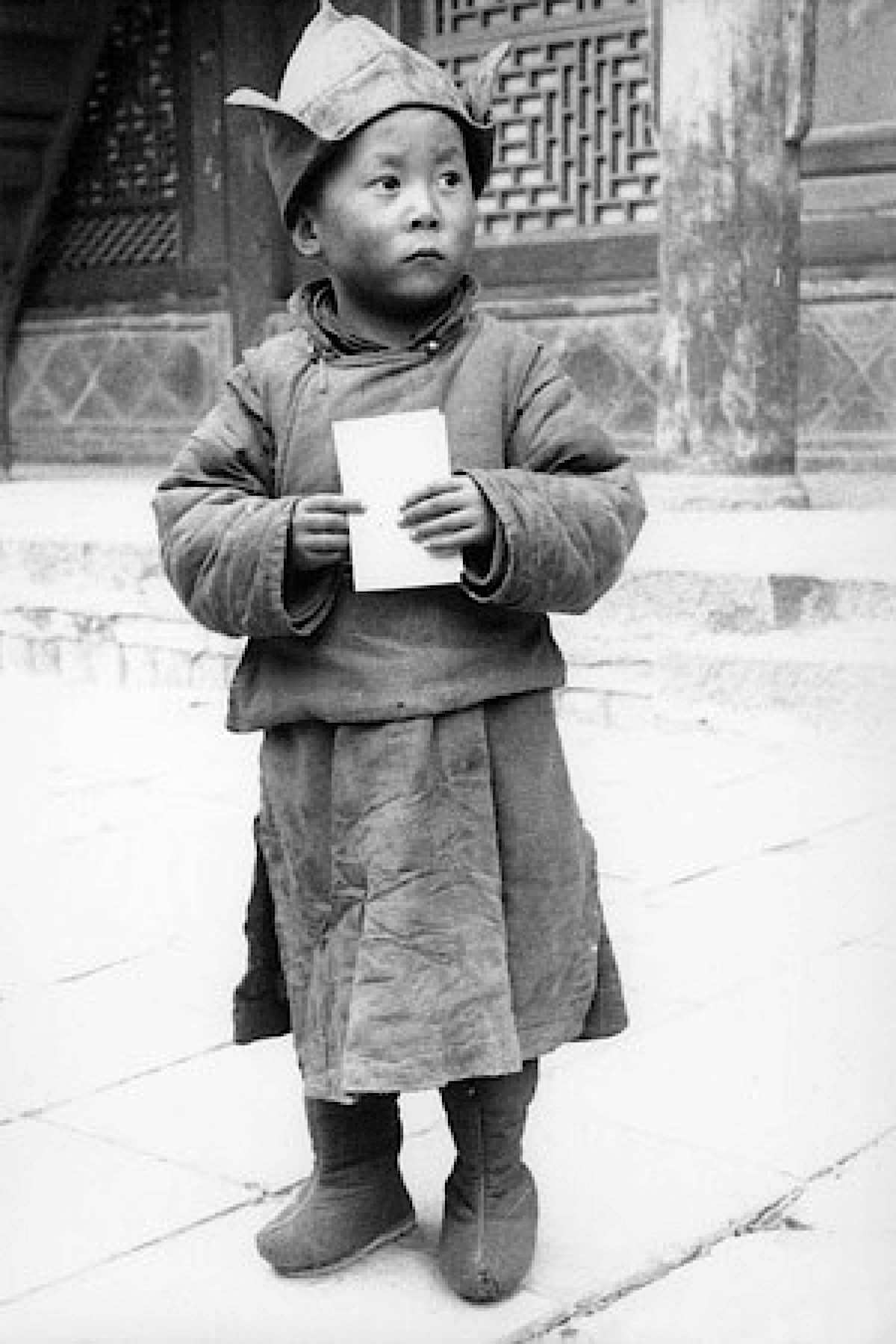 The Dalai Lama at the age of four in Kumbum Monastery in Amdo, eastern Tibet. Office of His Holiness the Dalai Lama. Imagine, the future this compassionate young monk faced as events unfolded in Tibet. Through steadfast compassion and wisdom, His Holiness remains a source of inspiration and strength.
The Dalai Lama at the age of four in Kumbum Monastery in Amdo, eastern Tibet. Office of His Holiness the Dalai Lama. Imagine, the future this compassionate young monk faced as events unfolded in Tibet. Through steadfast compassion and wisdom, His Holiness remains a source of inspiration and strength.
Prevention of Obstacles
How do we prevent these difficult situations from interfering with our spiritual practice — our Dharma activities? What does this mean in context of a Buddhist practitioner? What are the karmic implications? How do we help purify our obscurations and obstacles — to minimize the disasters, reduce our suffering, and the suffering of those around us?
“Experiencing these difficulties is a sign that you are actually moving. Whether the road is smooth or bumpy, it is good that you are moving along. When you begin practices, these obstacles will manifest.”
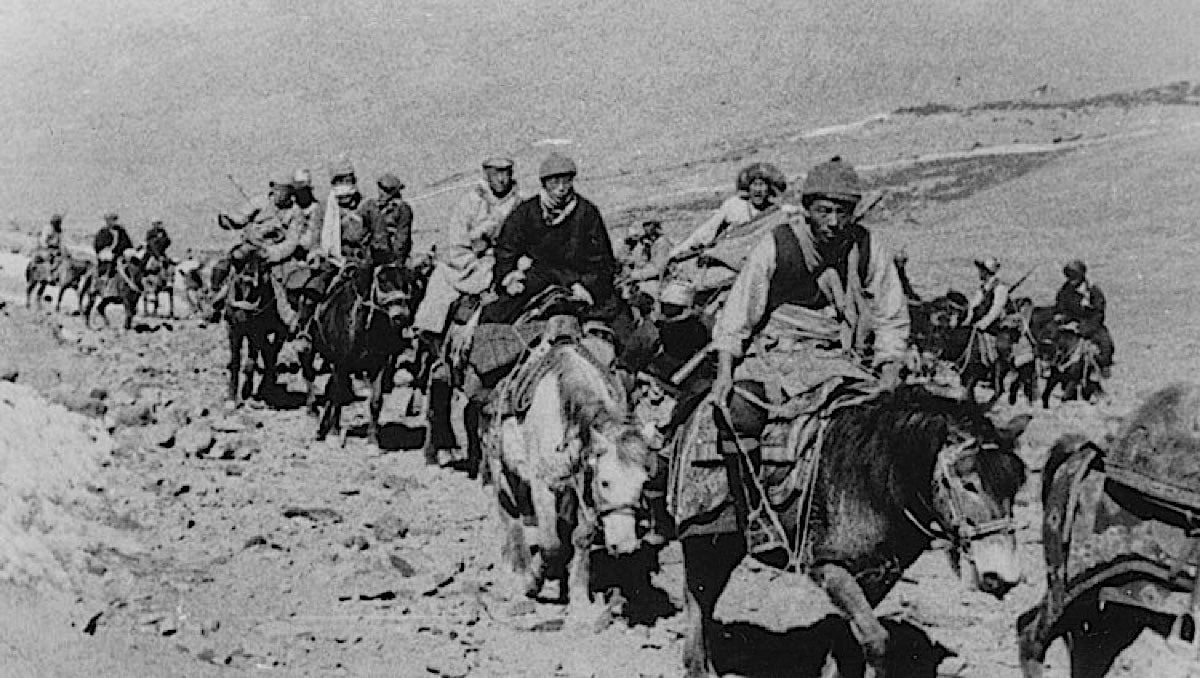 In March 1959, His Holiness the 14th Dalai Lama was forced into exile. Here, in a photo from the office of His Holiness, we see the ordeal and obstacles he and his people faced. In the face of that His Holiness is a shining example of Compassion and love.
In March 1959, His Holiness the 14th Dalai Lama was forced into exile. Here, in a photo from the office of His Holiness, we see the ordeal and obstacles he and his people faced. In the face of that His Holiness is a shining example of Compassion and love.
Obstacles and difficulties are a sign of progress because they show that we are moving forward. Many times, these obstacles are actually created by our own actions — such as in the case of the water pipes bursting. Other times, they are due to outside forces, such as the horse being heaving and asthmatic with the heat.
In either case, it is important to remember that we can’t control everything — and that’s okay. What’s important is how we deal with these obstacles when they come up. Do we let them stop us from our Dharma practice? Or do we see them as an opportunity to grow and purify our negativities?
It is said that Vajrayana Buddhism is the fastest path to enlightenment — but it is also the most difficult. This is because the Vajrayana practitioner works with their own obstacles and negativities directly, in order to purify them. This can be a difficult and painful process, but it is also said to be the most effective way to achieve Liberation. In Vajrayana, the expectation of gurus for their students is that they will practice faithfully, diligently and daily.
Green Tara practice and mantra is famous for overcoming obstacles, even urgent, deadly, worldly dangers:
So, how can we work with our own obstacles and negativities? First, we need to identify them. What are the things that cause us suffering? What are the things that make it difficult for us to maintain our Dharma practice? Once we know what these things are, we can start to work on them.
This might mean making some changes in our lives — such as letting go of attachments or changing our habits. It might also mean doing some specific practices to purify our negativities — such as reciting mantras or doing Vajrasattva practice. Whatever it is, the important thing is that we are taking action to improve our situation.
Obstacles and difficulties are a part of life, but we don’t have to let them stop us from practicing Dharma. By working with our own obstacles, we can actually use them as a tool for our own spiritual growth. In this way, we can turn our difficulties into a sign of progress on the path to Liberation.
Vajrayana Methods of Averting Obstacles
Most famous among the obstacle removers in terms of Enlightened Deities are the practices of Green Tara — and all of the 21 Taras — and Vajrakilaya. Both, represent the “activity of all the Buddhas.” Where Avalokiteshvara represents the compassion of all the Buddhas, and Manjushri the wisdom of all the Buddhas, both Green Tara and Vajrakilaya represent the “activity of all the Buddhas.” The main difference is the character of practice: Tara is peaceful and accessible, while Vajrakilaya is supremely wrathful and requires permission for the deeper practices.
Prayers and mantras for both are accessible to all. See the prayer to Vajrakilaya by the Great Fifth Dalai Lama below, along with mantra videos for both Tara and Vajrakilaya.These are the “active” practices for removing obstacles and creating positive karmas and blessings.
General obstacle-removing practices
The other methods often recommended, to all practitioners is Vajrasattva purification — since purifying all negative karmas past and present is the method to remove future obstacles. Vajrasattva practice is known for purifying these negative karmas before they ripen. How, you ask? By creating virtues — in this case confessing the negative karmas and promising not to repeat — we create merit which helps offset our past negative karmas.
See the video below on Vajrasattva visualization and practice with mantra (nonmusical, chanted in Sanskrit.)Four-Line Prayer to Remove Obstacles
Guru Rinpoche Padmasambhava practice is also strongly recommended by many teachers. When instructing Lady Yeshe Tosgyal, for example, he explained how he would always help those who call out to him.
In Vajrayana Buddhism, Guru Rinpoche is the second Buddha. One famous practice revealed by Orgyen Chokyur Denchen Lingpa is the “the Prayer Which Removes All Obstacles from the Path (Barché Lamsel)” which is in full below. A shorter Guru Rinpoche prayer, famous for removing obstacles to is the Six Vajra Lines:
༄༅། །རྡོ་རྗེའི་ཚིག་རྐང་དྲུག་གི་གསོལ་འདེབས།
The Prayer in Six Vajra Lines
revealed by Chokgyur Dechen Lingpa
དུས་གསུམ་སངས་རྒྱས་གུ་རུ་རིན་པོ་ཆེ༔
dü sum sangye guru rinpoche
Embodiment of buddhas of past, present and future, Guru Rinpoche;
དངོས་གྲུབ་ཀུན་བདག་བདེ་བ་ཆེན་པོའི་ཞབས༔
ngödrub kün dak dewa chenpö zhab
Master of all siddhis, Guru of Great Bliss;
བར་ཆད་ཀུན་སེལ་བདུད་འདུལ་དྲག་པོ་རྩལ༔
barché kün sel düdul drakpo tsal
Dispeller of all obstacles, Wrathful Subjugator of Māras;
གསོལ་བ་འདེབས་སོ་བྱིན་གྱིས་བརླབ་ཏུ་གསོལ༔
solwa deb so jingyi lab tu sol
To you I pray: inspire me with your blessing,
ཕྱི་ནང་གསང་བའི་བར་ཆད་ཞི་བ་དང༌༔
chi nang sangwé barché zhiwa dang
So that outer, inner and secret obstacles are dispelled
བསམ་པ་ལྷུན་གྱིས་འགྲུབ་པར་བྱིན་གྱིས་རློབས༔
sampa lhün gyi drubpar jingyi lob
And all my aspirations are spontaneously fulfilled. [3]
It is important in understanding how Yidam deity practice helps remove our obstacles to understanding that it should be a daily, long-term practice. A sudden burst of practices, in an emergency, can certainly help us, but it is more effective if we’ve be accumulating merit and purifying karma over a long period of time with these great Yidams.
Enlightened Protectors in Vajrayana
Generally, Tara, Vajrakilaya, and Vajrasattva practices — or any practices of Buddhas and personal Yidams — are the most highly recommended for most of us. They are effective, powerful, meditative, and moving. They help us simultaneously purify and remove obstacles while also progressing in our Dharma practices of merit accumulation, compassion, loving-kindness, and wisdom meditation.
For senior practitioners, who have permission and empowerment, there may be time to bring in the “big guns” for obstacle removal. Again, as with Yidam practices, long-term offerings and practices — for example, daily tea offerings to protectors — is the best approach, rather than a sudden “emergency” puja. The merit accumulated is much greater, which helps us in overcoming our obstacles.
We’ve previously covered protectors such as Palden Lhamo — the great Mother Protector, who is also the protector of His Holiness the Dalai Lama — Black Mahakala, and other great Enlightened Protectors. [Some linked features and videos below.]
Here, we’re only focused on Enlightened protectors, who are aspects of the great Bodhisattvas and Yidams. Worldly protectors are not generally recommended as a practice by many teachers, and in any case, requires permission and training. When approaching Enlightened Protectors, the worst that can happen is nothing (if you have no connection) — as Enlightened, wrathful deities, you can never be harmed. They only work for the benefit of sentient beings.
Wrathful Protectors are not Yidams
Wrathful Enlightened protectors are NEVER self-generated. You do not usually take them as a Yidam practice. For example, Vajrakilaya is the supreme wrathful emanation of Vajrasattva — but is NOT a protector; he is a Yidam, albeit a powerful, wrathful one. We can, if we have the permission of a teacher via empowerment, self-generate as Vajrakilaya and have him as our daily practice.
On the other hand, Palden Lhamo, who is certainly an Enlightened Protector, an aspect of Tara, is NOT a Yidam and we would never self-generate as Palden Lhamo. Always seek the advice of your qualified teacher.
Examples of Enlightened Protectors who are NOT Yidams:
Palden Lhamo or Shri Devi is an emanation of Tara — so the ultimately ferocious activity Protector Six-Armed Black Mahakala is an emanation of Chenrezig Begtse Chen is a protector aspect of Amitabha AchalaExamples of Wrathful Deities who are protective, but Yidams rather than protectors (although in some schools and lineages they are classified as protectors — or sometimes as BOTH — as in the 10 Wrathful ones):
Hayagriva, wrathful emanation of Amitabha and Chenrezig Yamantaka, wrathful emanation of Manjushri Ekatjati, wrathful aspect of Tara.However, it is still recommended to have some connection and relationship with these great beings before approaching them in a time of need.
Protectors, in other words, even the Enlightened Protectors, are generally only practiced with permission.
3 Short Obstacle-Removing Prayers
“Oh Vajrakilaya who dwells in the central region of Oddiyana, destroyer of all the hosts of Mara, please come swiftly to my assistance! I take refuge in you until samsara is emptied.”
— The Great Fifth Dalai Lama
“To Tara who saves us from eight million dangers, I bow down.”
— His Holiness the Great 14th Dalai Lama
“In order to vanquish the hordes of obstructing demons that rise up against me from within and without, attacking me like an army on every side, I take refuge in you, Vajrakilaya. Come to my aid with your great power! Please remain until samsara is emptied.”
— The Great Fifth Dalai Lama
Kyabje Garchen Rinpoche speaks on overcoming obstacles, in this case especially Covid-19 and other diseases:
Short Vajrakilaya Dokpa
༄༅། །ཕུར་བཟློག་བསྡུས་པ།
Short Vajrakīla Dokpa
by the Fifth Dalai Lama
ཧཱུྃ། གཞི་དབྱིངས་འགྱུར་མེད་ཆོས་སྐུའི་ཀློང་ཡངས་ནས། །
hung, zhi ying gyurmé chökü long yang né
Hūṃ! Out of the unchanging space of the ground, dharmakāya’s vast expanse,
རྩལ་སྣང་འགགས་མེད་རྡོ་རྗེ་ཕུར་པའི་ལྷ། །
tsalnang gakmé dorjé purpé lha
You manifest unimpededly as its dynamic power, deities of Kīla—
དབྱིངས་རིག་དབྱེར་མེད་གཏོར་མ་འདི་བཞེས་ལ། །
yingrik yermé torma di zhé la
Please accept this torma of indivisible space and rigpa,
འཁྲུལ་སྣང་ནད་གདོན་དགྲ་བགེགས་དབྱིངས་སུ་ཟློག །
trulnang ne dön dra gek ying su dok
And dispel all delusory appearances, sickness, harmful influences, enemies and obstructing forces into all-pervading space!
ཟ་ཧོར་གྱི་བན་དེས་སྦྱར་བའོ། །
This was composed by the monk from the Zahor family.
Vajrakilaya Practice — the ultimate obstacle remover
Vajrakilaya is known as the supreme obstacle-remover. Why? Because he is none other than Vajrasattva in his most wrathful form.
In The Dark Red Amulet (a book on Vajrakilaya practices) Khenchen Palden Sherab Rinpoche and Khenpo Tsewang Dongyal Rinpoche explain that obstacles may be a sign of progress in practice, and what to look for [1]:
“In his Dzogchen teachings, Guru Padma Sambhava urged his disciples to keep going beyond the boulders on the road of meditation. In Tibet, there are lots of boulders on the roads, but in America, we would probably say “the potholes in the streets.” Experiencing these difficulties is a sign that you are actually moving. Whether the road is smooth or bumpy, it is good that you are moving along. When you begin practices, these obstacles will manifest. At such times, maintain your strength and renew your commitment. You need stability and continuity to overcome these episodes. There are many ways in which signs can occur. Difficult situations can arise externally, internally, and secretly. Externally, things may happen that you did not expect, or things may not proceed the way you want them to. You may find that when one problem is solved, another problem arises.On the inner level, you might have health problems, discomfort, insomnia, long and involved dreams, and other unusual phenomena. The secret signs show up in the emotions. You may have more expectations and anxiety about the teachings. You may have doubts about the teacher and other sangha members, less certainty about what you are doing, or less compassion than before. These signs do not mean that you are losing the ability to love and be kind. When we come to these rough places in the road, we should always persevere, strengthen our practice, and keep moving toward our goal.
Positive signs of achievement may also occur. Externally, there may be periods where everything goes along nicely. Inwardly, your body feels peaceful and healthy, and it functions well. Emotionally, you feel relaxed, and anger, jealousy, and other emotions do not disturb you as they did before. We should not cling to positive signs, but maintain the ultimate view in every situation from now until we attain enlightenment.
The strongest and most positive signs of achievement—in Vajrakilaya practice, for example—are the three signs known as the body, speech, and mind signs of Vajrakilaya. Among the signs of the body are that the practitioner’s physical form becomes very bright, light, joyful, and peaceful. One has visions, dreams, or direct perceptions of the emanations of Vajrakilaya. Also, one’s phurba on the shrine might spark and radiate light. These phenomena were quite common in Tibet. Almost every monastery had special phurbas that danced on the shrine. These are all signs of the physical achievement of Vajrakilaya.
The signs of the speech achievement of Vajrakilaya involve the practitioner’s speech becoming very powerful and perfect, and one’s expressions of wisdom spontaneously expanding. For example, there are yogis who can write beautiful dharma songs that send special messages to sentient beings. Hearing the Vajrakilaya mantras, such as the syllable HUNG, resounding from the shrine or from trees, mountains, or open space is another sign that one has achieved the speech of Vajrakilaya.
The initial signs of achieving the mind of Vajrakilaya are temporary experiences of joy, peace, and a very relaxed state of mind. The ultimate sign of accomplishing the mind of Vajrakilaya is a perfect understanding of the nonduality of the awareness wisdom phurba and the immeasurable compassion phurba. Boundless compassion arises for all beings while the mind abides in the expanse of wisdom beyond concepts. The moment anything arises, it is liberated in the very space of its appearance. At the same time, unceasing great compassion arises for all beings without any expectation or reluctance.
There are also special signs, such as a pure understanding that the teacher, the teachings, and the sangha are all part of the mandala of Vajra kilaya. Another is the ability to perform the four actions of Vajrakilaya: pacifying, increasing, overpowering, and subjugating. You become efficient at whatever you do.
These are signs of having achieved a measure of the realization of Vajrakilaya. In any case, it is important not to become over-involved with the appearance of signs, whether good or bad, but simply continue to practice and meditate.”
Varjakilaya Ultimate Dokpa
ཆོས་ཉིད་དོན་གྱི་བཟློག་པ་བཞུགས་སོ༔The Ultimate, Natural Dispeller of Obstacles
by Tertön Sogyal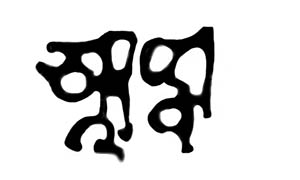 ཆོས་ཉིད་དོན་གྱི་བཟློག་པ་ཞེས་བྱ་བ༔ རྣམ་འབྱོར་པ་རྣམས་དགོངས་པ་མཉམ་ཉིད་ཀྱི་ངང་ནས་རྒྱས་འདེབས་ཆེན་པོའི་ཏིང་ངེ་འཛིན་ལས་བཞེངས་ཏེ༔
ཆོས་ཉིད་དོན་གྱི་བཟློག་པ་ཞེས་བྱ་བ༔ རྣམ་འབྱོར་པ་རྣམས་དགོངས་པ་མཉམ་ཉིད་ཀྱི་ངང་ནས་རྒྱས་འདེབས་ཆེན་པོའི་ཏིང་ངེ་འཛིན་ལས་བཞེངས་ཏེ༔
From the experience of realization and equality, practitioners arise from the samādhi of great sealing and recite the following:
ཧཱུྃ༔ ཆོས་ཉིད་འགྱུར་བ་མེད་པ་ལས༔
hung, chönyi gyurwa mepa lé
Hūṃ! Out of the unchanging dharmatā—reality itself,
རང་བྱུང་འཁོར་འདས་སྣང་སྲིད་ཀུན༔
rangjung khordé nangsi kün
Saṃsāra and nirvāṇa, appearance and existence, naturally arise—
གཉིས་མེད་བདེ་ཆེན་རང་བཞིན་དུ༔
nyimé dechen rangzhin du
Although we do not realize their nature, great bliss beyond duality,
མ་རྟོགས་གཉིས་སུ་འཛིན་པ་ཡང་༔
ma tok nyisu dzinpa yang
And instead we cling to them dualistically,
མ་བཅོས་མཉམ་པའི་ཏིང་འཛིན་གྱིས༔
machö nyampé tingdzin gyi
Still, through the samādhi of uncontrived equality,
འཛིན་མེད་རོལ་པ་ཆེན་པོར་བཟློག༔
dzinmé rolpa chenpor dok
Let this be dispelled within the great play of non-grasping!
འཁྲུལ་པར་སེམས་པའི་དུག་ལྔ་དང་༔
trulpar sempé duk nga dang
There are five poisons of the ordinary deluded mind,
དུག་ལྔ་སྒྲོལ་བའི་ཐབས་ཆེན་པོ༔
duk nga drolwé tab chenpo
And great methods for liberating these five poisons—
དབྱིངས་ཀྱི་ངང་ལས་མ་གཡོས་ཕྱིར༔
ying kyi ngang lé ma yö chir
As they have not strayed from the experience of basic space,
ཡེ་ནས་ཐ་དད་གཉིས་སུ་མེད༔
yené tadé nyisumé
They have always been inseparable and non-dual,
གཉིས་སུ་མེད་པ་ཆོས་ཀྱི་སྐུ༔
nyisumepa chö kyi ku
In this non-duality, which is the dharmakāya,
སྤྲོས་བྲལ་བདེ་བ་ཆེན་པོར་བཟློག༔
trödral dewa chenpor dok
Great bliss beyond conceptual elaboration, let them be averted!
གཏི་མུག་མ་རིག་ཆེན་པོ་ཡང་༔
timuk marik chenpo yang
Great ignorance and delusion too
རང་གསལ་མེ་ལོང་ཡེ་ཤེས་ཏེ༔
rangsal melong yeshe té
Are the naturally clear mirror-like wisdom.
གཉིས་སྣང་ཞེན་པས་འཐིབ་པ་རྣམས༔
nyinang zhenpé tibpa nam
Let obscurations brought on by attachment to dualistic perception
གཏི་མུག་རྡོ་རྗེ་ཉིད་དུ་བཟློག༔
timuk dorje nyi du dok
Be averted in the vajra nature of delusion itself!
ཞེ་སྡང་གདུག་པའི་རྟོག་པ་ཡང་༔
zhedang dukpé tokpa yang
Thoughts of hostility and anger too
རང་བྱུང་ཆོས་དབྱིངས་ཡེ་ཤེས་ཏེ༔
rangjung chöying yeshe té
Are the naturally arisen wisdom of dharmadhātu.
གཉིས་སྣང་ཞེན་པས་མནར་བ་རྣམས༔
nyinang zhenpé narwa nam
Let torments brought on by attachment to dualistic perception
ཞེ་སྡང་རྡོ་རྗེ་ཉིད་དུ་བཟློག༔
zhedang dorje nyi du dok
Be averted in the vajra nature of anger itself!
ང་རྒྱལ་གཏུམ་པའི་རྟོག་པ་ཡང་༔
ngagyal tumpé tokpa yang
Thoughts of pride and stubborn arrogance too
རང་བྱུང་མཉམ་ཉིད་ཡེ་ཤེས་ཏེ༔
rangjung nyamnyi yeshe té
Are the naturally arisen wisdom of equality.
གཉིས་སྣང་ཞེན་པས་ཁེངས་པ་རྣམས༔
nyinang zhenpé khengpa nam
Let haughtiness brought on by attachment to dualistic perception
ང་རྒྱལ་རྡོ་རྗེ་ཉིད་དུ་བཟློག༔
ngagyal dorje nyi du dok
Be averted in the vajra nature of pride itself!
འདོད་ཆགས་འཛིན་པའི་རྟོག་པ་ཡང་༔
döchak dzinpé tokpa yang
Thoughts of desire and clinging too
རང་བྱུང་སོར་རྟོག་ཡེ་ཤེས་ཏེ༔
rangjung sortok yeshe té
Are the naturally arisen wisdom of discernment.
གཉིས་སྣང་ཞེན་པས་འཆིང་བ་རྣམས༔
nyinang zhenpé chingwa nam
Let restraints brought about by attachment to dualistic perception
འདོད་ཆགས་རྡོ་རྗེ་ཉིད་དུ་བཟློག༔
döchak dorje nyi du dok
Be averted in the vajra nature of desire itself!
ཕྲག་དོག་རྒོད་པའི་རྟོག་པ་ཡང་༔
trakdok göpé tokpa yang
Thoughts of rampant jealousy too
རང་བྱུང་བྱ་གྲུབ་ཡེ་ཤེས་ཏེ༔
rangjung ja drub yeshe té
Are the naturally arisen all-accomplishing wisdom.
གཉིས་སྣང་ཞེན་པས་འཁྲུགས་པ་རྣམས༔
nyinang zhenpé trukpa nam
Let disturbances brought on by attachment to dualistic perception
ཕྲག་དོག་རྡོ་རྗེ་ཉིད་དུ་བཟློག༔
trakdok dorje nyi du dok
Be averted in the vajra nature of jealousy itself!
འཕོ་འགྱུར་གཉིས་མེད་ཆོས་དབྱིངས་ལས༔
pogyur nyimé chöying lé
Out of the dharmadhātu, beyond the duality of change and transformation,
སྒྱུ་མའི་ཆོ་འཕྲུལ་ཅིར་ཡང་འཆར༔
gyumé chotrul chiryang char
Illusory appearances arise magically in all manner of forms.
ཐ་དད་འཛིན་པས་སྣ་ཚོགས་གྲུབ༔
tadé dzinpé natsok drub
By perceiving them as distinct, variety is created,
མ་རིག་འགྲོ་རྣམས་བདེན་པར་འཁྲུལ༔
marik dro nam denpar trul
And ignorant beings stray into the belief that things are real.
མཉམ་ཉིད་རྟོགས་པའི་རྒྱལ་བ་ཡིས༔
nyamnyi tokpé gyalwa yi
To free them, victorious buddhas, who have realized equality,
སྒྲོལ་ཕྱིར་ཕྲིན་ལས་སྣ་ཚོགས་སྟོན༔
drol chir trinlé natsok tön
Display a variety of enlightened activities.
དབྱིངས་ལས་མ་གཡོས་རོལ་པའི་རྒྱན༔
ying lé ma yö rolpé gyen
Never straying from basic space, all adornments of display
ཐམས་ཅད་རྒྱལ་བའི་ཕྲིན་ལས་ཏེ༔
tamché gyalwé trinlé té
Are the enlightened activity of victorious buddhas.
ཐམས་ཅད་ཡེ་ནས་མཉམ་པ་ཉིད༔
tamché yené nyampa nyi
They are and always have been equality itself.
སྤང་བླང་མེད་པའི་འཁའ་དབྱིངས་སུ༔
panglang mepé kha ying su
In this sky-like sphere, beyond acceptance and rejection,
གཉིས་སྣང་རྟོག་ཚོགས་ཐམས་ཅད་བཟློག༔
nyinang toktsok tamché dok
Let all thoughts of dualistic perception be averted!
ཧཱུྃ༔ ང་ནི་རྡོ་རྗེའི་རིག་པ་འཛིན༔
hung, nga ni dorje rigpa dzin
Hūṃ! I am the holder of vajra-like awareness,
དུས་གསུམ་རྒྱལ་བའི་བདག་ཉིད་ཆེ༔
dü sum gyalwé daknyi ché
Great embodiment of the buddhas of past, present and future,
རང་བྱུང་དགོངས་པའི་བྱིན་རླབས་ཀྱིས༔
rangjung gongpé jinlab kyi
Through the inspiration and blessings of naturally arisen realization,
འཁོར་འདས་བདེན་ཞེན་སྒྱུ་མ་ཀུན༔
khordé denzhen gyuma kün
Let all illusory attachments to the reality of saṃsāra and nirvāṇa
ཡེ་ནས་སྤྲོས་བྲལ་མཁའ་ལ་བཟློག༔
yené trödral kha la dok
Be dispelled within the space that has always been free from conceptual elaboration,
ལྷུན་གྱིས་གྲུབ་པའི་དབྱིངས་སུ་བཟློག༔
lhün gyi drubpé ying su dok
Be dispelled within spontaneously present basic space!
བདེ་ཆེན་ཟུང་འཇུག་ངང་དུ་བཟློག༔
dechen zungjuk ngang du dok
Be dispelled within the state of unified great bliss!
མ་སྐྱེས་རང་གནས་ཆེན་པོར་བཟློག༔
makyé rangné chenpor dok
Be dispelled within the great unborn natural state!
འདུ་འབྲལ་མེད་པའི་ངང་དུ་བཟློག༔
dudral mepé ngang du dok
Be dispelled within the state beyond union and separation!
སྐྱེ་འགག་གཉིས་མེད་ཀློང་དུ་བཟློག༔
kyegak nyimé long du dok
Be dispelled within the expanse beyond both arising and ceasing!
ཅེས་མཉམ་པར་བཞག་གོ༔
With this, rest in meditative equipoise.
Simhamukha and the Wrathful Wisdom Dakinis
Simhamukha, the Snow-Lion-Faced Dakini — more commonly known as just “Lion-Faced Dakini — is one of the best known of the wrathful wisdom Dakinis who specialize in removing obstacles. Even the most terrible of obstacles such as war, strife, and natural disasters can — according to Tantra — be reduced or eliminated through her ferocious attention. Other wrathful Dakinis also are well-known for activities averting obstacles and disasters.
For a full feature on Simhamukha, the Snow-Lion-Faced Dakini, see (coming soon)>>Barche Lamsel — The Prayer Which Removes All Obstacles from the Path (Barché Lamsel) : Guru Rinpoche
༃ གསོལ་འདེབས་བར་ཆད་ལམ་སེལ་བཞུགས༔
The Prayer Which Removes All Obstacles from the Path (Barché Lamsel)
revealed by Orgyen Chokgyur Dechen Lingpa
ཨོཾ་ཨཱཿཧཱུྃ་བཛྲ་གུ་རུ་པདྨ་སིདྡྷི་ཧཱུྃ༔
om ah hung benza guru pema siddhi hung
oṃ āh hūṃ vajra guru padma siddhi hūṃ
ཆོས་སྐུ་སྣང་བ་མཐའ་ཡས་ལ་གསོལ་བ་འདེབས༔
chöku nangwa tayé la solwa deb
To the dharmakāya Amitābha we pray!
ལོངས་སྐུ་ཐུགས་རྗེ་ཆེན་པོ་ལ་གསོལ་བ་འདེབས༔
longku tukjé chenpo la solwa deb
To the saṃbhogakāya—the Great Compassionate One—we pray!
སྤྲུལ་སྐུ་པདྨ་འབྱུང་གནས་ལ་གསོལ་བ་འདེབས༔
tulku pema jungné la solwa deb
To the nirmāṇakāya Padmākara we pray!
བདག་གི་བླ་མ་ངོ་མཚར་སྤྲུལ་པའི་སྐུ༔
dak gi lama ngotsar trulpé ku
Wondrous emanation, master of mine,
རྒྱ་གར་ཡུལ་དུ་སྐུ་འཁྲུངས་ཐོས་བསམ་མཛད༔
gyagar yul du kutrung tö sam dzé
In India, you were born, you studied and you contemplated;
བོད་ཡུལ་དབུས་སུ་ཞལ་བྱོན་དྲེགས་པ་བཏུལ༔
böyul ü su zhal jön drekpa tul
To the heart of Tibet you came, to subjugate its arrogant demons,
ཨོ་རྒྱན་ཡུལ་དུ་སྐུ་བཞུགས་འགྲོ་དོན་མཛད༔
orgyen yul du kuzhuk dro dön dzé
In Orgyen you dwell, accomplishing the benefit of beings:
ཐུགས་རྗེས་བདག་ལ་བྱིན་གྱིས་རློབས༔
tukjé dak la jingyi lob
With your compassion, inspire us with your blessing!
བརྩེ་བས་བདག་སོགས་ལམ་སྣ་དྲོངས༔
tsewé dak sok lam na drong
With your love, guide us and others along the path!
དགོངས་པས་བདག་ལ་དངོས་གྲུབ་སྩོལ༔
gongpé dak la ngödrub tsol
With your realization, grant us attainments!
ནུས་པས་བདག་སོགས་བར་ཆད་སོལ༔
nüpé dak sok barché sol
With your power, dispel the obstacles facing us all!
ཕྱི་ཡི་བར་ཆད་ཕྱི་རུ་སོལ༔
chi yi barché chi ru sol
Outer obstacles—dispel them externally,
ནང་གི་བར་ཆད་ནང་དུ་སོལ༔
nang gi barché nang du sol
Inner obstacles—dispel them internally,
གསང་བའི་བར་ཆད་དབྱིངས་སུ་སོལ༔
sangwé barché ying su sol
Secret obstacles—dispel them into space!
གུས་པས་ཕྱག་འཚལ་སྐྱབས་སུ་མཆི༔
güpé chaktsal kyab su chi
In devotion, I pay homage and take refuge in you!
ཨོཾ་ཨཱཿཧཱུྃ་བཛྲ་གུ་རུ་པདྨ་སིདྡྷི་ཧཱུྃ༔
om ah hung benza guru pema siddhi hung
oṃ āh hūṃ vajra guru padma siddhi hūṃ
Gyalwé Dungdzin1
སྐུ་ཡི་ངོ་མཚར་མཐོང་བའི་ཚེ༔
ku yi ngotsar tongwé tsé
When we gaze on the wonder of your perfect form,
གཡས་པས་རལ་གྲིའི་ཕྱག་རྒྱ་མཛད༔
yepé raldri chakgya dzé
Your right hand forms the mudrā of the sword,
གཡོན་པས་འགུགས་པའི་ཕྱག་རྒྱ་མཛད༔
yönpé gukpé chakgya dzé
Your left in the mudrā of summoning.
ཞལ་བགྲད་མཆེ་གཙིགས་གྱེན་ལ་གཟིགས༔
zhal dré chetsik gyen la zik
Your mouth held open, with teeth bared, you gaze up into the sky.
རྒྱལ་བའི་གདུང་འཛིན་འགྲོ་བའི་མགོན༔
gyalwé dungdzin drowé gön
O Gyalwé Dungdzin, Protector of Beings:
ཐུགས་རྗེས་བདག་ལ་བྱིན་གྱིས་རློབས༔
tukjé dak la jingyi lob
With your compassion, inspire us with your blessing!
བརྩེ་བས་བདག་སོགས་ལམ་སྣ་དྲོངས༔
tsewé dak sok lam na drong
With your love, guide us and others along the path!
དགོངས་པས་བདག་ལ་དངོས་གྲུབ་སྩོལ༔
gongpé dak la ngödrub tsol
With your realization, grant us attainments!
ནུས་པས་བདག་སོགས་བར་ཆད་སོལ༔
nüpé dak sok barché sol
With your power, dispel the obstacles facing us all!
ཕྱི་ཡི་བར་ཆད་ཕྱི་རུ་སོལ༔
chi yi barché chi ru sol
Outer obstacles—dispel them externally,
ནང་གི་བར་ཆད་ནང་དུ་སོལ༔
nang gi barché nang du sol
Inner obstacles—dispel them internally,
གསང་བའི་བར་ཆད་དབྱིངས་སུ་སོལ༔
sangwé barché ying su sol
Secret obstacles—dispel them into space!
གུས་པས་ཕྱག་འཚལ་སྐྱབས་སུ་མཆི༔
güpé chaktsal kyab su chi
In devotion, I pay homage and take refuge in you!
ཨོཾ་ཨཱཿཧཱུྃ་བཛྲ་གུ་རུ་པདྨ་སིདྡྷི་ཧཱུྃ༔
om ah hung benza guru pema siddhi hung
oṃ āh hūṃ vajra guru padma siddhi hūṃ
Mawé Sengé
དམ་ཆོས་རིན་ཆེན་གསན་པའི་ཚེ༔
damchö rinchen senpé tsé
When hearing the priceless teachings of Dharma,
སྐུ་གསལ་འོད་ཟེར་མདངས་དང་ལྡན༔
ku sal özer dang dangden
Your body shines with a dazzling radiance of light,
ཕྱག་གཡས་སྡེ་སྣོད་གླེགས་བམ་བསྣམས༔
chak yé denö lekbam nam
In your right hand, volumes of the tripiṭaka,
གཡོན་པས་ཕུར་པའི་པུསྟི་བསྣམས༔
yönpé purpé puti nam
In your left, the texts of Kīlaya.
ཟབ་མོའི་ཆོས་རྣམས་ཐུགས་སུ་ཆུད༔
zabmö chö nam tuk su chü
All these profound teachings have infused your mind,
ཡང་ལེ་ཤོད་ཀྱི་པཎྜི་ཏ༔
yangleshö kyi pandita
O Paṇḍita of Yangleshö:
ཐུགས་རྗེས་བདག་ལ་བྱིན་གྱིས་རློབས༔
tukjé dak la jingyi lob
With your compassion, inspire us with your blessing!
བརྩེ་བས་བདག་སོགས་ལམ་སྣ་དྲོངས༔
tsewé dak sok lam na drong
With your love, guide us and others along the path!
དགོངས་པས་བདག་ལ་དངོས་གྲུབ་སྩོལ༔
gongpé dak la ngödrub tsol
With your realization, grant us attainments!
ནུས་པས་བདག་སོགས་བར་ཆད་སོལ༔
nüpé dak sok barché sol
With your power, dispel the obstacles facing us all!
ཕྱི་ཡི་བར་ཆད་ཕྱི་རུ་སོལ༔
chi yi barché chi ru sol
Outer obstacles—dispel them externally,
ནང་གི་བར་ཆད་ནང་དུ་སོལ༔
nang gi barché nang du sol
Inner obstacles—dispel them internally,
གསང་བའི་བར་ཆད་དབྱིངས་སུ་སོལ༔
sangwé barché ying su sol
Secret obstacles—dispel them into space!
གུས་པས་ཕྱག་འཚལ་སྐྱབས་སུ་མཆི༔
güpé chaktsal kyab su chi
In devotion, I pay homage and take refuge in you!
ཨོཾ་ཨཱཿཧཱུྃ་བཛྲ་གུ་རུ་པདྨ་སིདྡྷི་ཧཱུྃ༔
om ah hung benza guru pema siddhi hung
oṃ āh hūṃ vajra guru padma siddhi hūṃ
Kyéchok Tsul Zang
དམ་ཅན་དམ་ལ་བཏགས་པའི་ཚེ༔
damchen dam la takpé tsé
When placing under oath the protectors who abide by their vows
དྲི་མེད་གནས་མཆོག་ཉམས་རེ་དགའ༔
drimé né chok nyam ré ga
In that supreme place of power, immaculate and enchanting,
རྒྱ་གར་བོད་ཡུལ་ས་མཚམས་སུ༔
gyagar böyul satsam su
On the very border of India and Tibet,2
བྱིན་གྱིས་བརླབས་ནས་བྱོན་པའི་ཚེ༔
jingyi lab né jönpé tsé
You grant your blessing, and as soon as you arrive
དྲི་བསུང་སྤོས་ངད་ལྡན་པའི་རི༔
drisung pö ngé denpé ri
The mountain becomes fragrant, a sweet scent wafting through the air,
མེ་ཏོག་པདྨ་དགུན་ཡང་སྐྱེ༔
metok pema gün yang kyé
Even in winter lotus flowers bloom,
ཆུ་མིག་བྱང་ཆུབ་བདུད་རྩིའི་ཆུ༔
chumik changchub dütsi chu
And there flows a spring called ‘Nectar of Enlightenment’.
བདེ་ལྡན་དེ་ཡི་གནས་མཆོག་ཏུ༔
deden dé yi né chok tu
In this supreme and sacred place, inundated with bliss,
སྐྱེས་མཆོག་ཚུལ་བཟང་ཆོས་གོས་གསོལ༔
kyechok tsul zang chögö sol
O Kyéchok Tsul Zang, clad in Dharma robes,
ཕྱག་གཡས་རྡོ་རྗེ་རྩེ་དགུ་བསྣམས༔
chak yé dorjé tsé gu nam
Your right hand wielding a nine-spoked vajra,
གཡོན་པས་རིན་ཆེན་ཟ་མ་ཏོག༔
yönpé rinchen zama tok
Your left holding a jewelled casket
རཀྟ་བདུད་རྩིས་ནང་དུ་གཏམས༔
rakta dütsi nang du tam
Brimful of the elixir of rakta.
མཁའ་འགྲོ་དམ་ཅན་དམ་ལ་བཏགས༔
khandro damchen dam la tak
You bind under oath the ḍākinīs and guardians who keep their pledges,
ཡི་དམ་ཞལ་གཟིགས་དངོས་གྲུབ་བརྙེས༔
yidam zhalzik ngödrub nyé
And you attain the siddhi of beholding the yidam deity face to face:
ཐུགས་རྗེས་བདག་ལ་བྱིན་གྱིས་རློབས༔
tukjé dak la jingyi lob
With your compassion, inspire us with your blessing!
བརྩེ་བས་བདག་སོགས་ལམ་སྣ་དྲོངས༔
tsewé dak sok lam na drong
With your love, guide us and others along the path!
དགོངས་པས་བདག་ལ་དངོས་གྲུབ་སྩོལ༔
gongpé dak la ngödrub tsol
With your realization, grant us attainments!
ནུས་པས་བདག་སོགས་བར་ཆད་སོལ༔
nüpé dak sok barché sol
With your power, dispel the obstacles facing us all!
ཕྱི་ཡི་བར་ཆད་ཕྱི་རུ་སོལ༔
chi yi barché chi ru sol
Outer obstacles—dispel them externally,
ནང་གི་བར་ཆད་ནང་དུ་སོལ༔
nang gi barché nang du sol
Inner obstacles—dispel them internally,
གསང་བའི་བར་ཆད་དབྱིངས་སུ་སོལ༔
sangwé barché ying su sol
Secret obstacles—dispel them into space!
གུས་པས་ཕྱག་འཚལ་སྐྱབས་སུ་མཆི༔
güpé chaktsal kyab su chi
In devotion, I pay homage and take refuge in you!
ཨོཾ་ཨཱཿཧཱུྃ་བཛྲ་གུ་རུ་པདྨ་སིདྡྷི་ཧཱུྃ༔
om ah hung benza guru pema siddhi hung
oṃ āh hūṃ vajra guru padma siddhi hūṃ
Dükyi Shéchen
རྒྱལ་བའི་བསྟན་པ་བཙུགས་པའི་ཚེ༔
gyalwé tenpa tsukpé tsé
When you establish the teaching of the buddhas,
གཡའ་རིའི་ནགས་ལ་སྒྲུབ་པ་མཛད༔
yari nak la drubpa dzé
And practise in the Slate Mountain forest,
བསྙེན་ཕུར་ནམ་མཁའི་དབྱིངས་སུ་འཕར༔
nyenpur namkhé ying su par
Your ‘kīla of approach’ soars into the wide open sky.
རྡོ་རྗེའི་ཕྱག་རྒྱས་བླངས་ཤིང་བསྒྲིལ༔
dorjé chakgyé lang shing dril
You catch it with the vajra mudrā, roll it
བསྒྲིལ་ཞིང་ཙནྡན་ནགས་སུ་འཕང་༔
dril zhing tsenden nak su pang
Between your hands and hurl it into the Sandalwood Forest,
མེ་འབར་འཁྲུགས་ཤིང་མཚོ་ཡང་སྐེམ༔
mebar truk shing tso yang kem
Which bursts into flames, evaporating its lake.
སྲིབ་ཀྱི་མུ་སྟེགས་ས་གང་བསྲེགས༔
sib kyi mutek sa gang sek
In an instant, you burn the land of the tīrthikas to ashes,
ཡཀྴ་ནག་པོ་རྡུལ་དུ་བརླག༔
yaksha nakpo dul du lak
And crush their dark yakṣa lords into dust.
འགྲན་གྱི་དོ་མེད་བདུད་ཀྱི་གཤེད༔
dren gyi domé dü kyi shé
O peerless Dükyi Shéchen:
ཐུགས་རྗེས་བདག་ལ་བྱིན་གྱིས་རློབས༔
tukjé dak la jingyi lob
With your compassion, inspire us with your blessing!
བརྩེ་བས་བདག་སོགས་ལམ་སྣ་དྲོངས༔
tsewé dak sok lam na drong
With your love, guide us and others along the path!
དགོངས་པས་བདག་ལ་དངོས་གྲུབ་སྩོལ༔
gongpé dak la ngödrub tsol
With your realization, grant us attainments!
ནུས་པས་བདག་སོགས་བར་ཆད་སོལ༔
nüpé dak sok barché sol
With your power, dispel the obstacles facing us all!
ཕྱི་ཡི་བར་ཆད་ཕྱི་རུ་སོལ༔
chi yi barché chi ru sol
Outer obstacles—dispel them externally,
ནང་གི་བར་ཆད་ནང་དུ་སོལ༔
nang gi barché nang du sol
Inner obstacles—dispel them internally,
གསང་བའི་བར་ཆད་དབྱིངས་སུ་སོལ༔
sangwé barché ying su sol
Secret obstacles—dispel them into space!
གུས་པས་ཕྱག་འཚལ་སྐྱབས་སུ་མཆི༔
güpé chaktsal kyab su chi
In devotion, I pay homage and take refuge in you!
ཨོཾ་ཨཱཿཧཱུྃ་བཛྲ་གུ་རུ་པདྨ་སིདྡྷི་ཧཱུྃ༔
om ah hung benza guru pema siddhi hung
oṃ āh hūṃ vajra guru padma siddhi hūṃ
Dzam Ling Gyen Chok
སྲིན་པོའི་ཁ་གནོན་མཛད་པའི་ཚེ༔
sinpö khanön dzepé tsé
When overpowering the rākṣasas,
ཁྱེའུ་ཆུང་སྤྲུལ་སྐུའི་ཆ་ལུགས་ཅན༔
khyé’u chung tulkü chaluk chen
You appear as a youth in nirmāṇakāya garb,
ཡ་མཚན་གཟུགས་བཟང་ཁ་དོག་ལེགས༔
yatsen zuk zang khadok lek
Your amazing, beautiful form, with its lovely hue,
ཚེམས་འགྲིགས་དབུ་སྐྲ་སེར་ལ་མཛེས༔
tsem drik utra ser la dzé
Perfect teeth and golden hair, gorgeous
དགུང་ལོ་བཅུ་དྲུག་ལོན་པའི་ཚུལ༔
gunglo chudruk lönpé tsul
Like a youth of sixteen years,
རིན་ཆེན་རྒྱན་ཆ་སྣ་ཚོགས་གསོལ༔
rinchen gyencha natsok sol
Wearing all the jewel ornaments.
ཕྱག་གཡས་འཁར་བའི་ཕུར་པ་བསྣམས༔
chak yé kharwé purpa nam
Your right hand grips a kīla of bronze,
བདུད་དང་སྲིན་པོའི་ཁ་གནོན་མཛད༔
dü dang sinpö khanön dzé
Subjugating māras and rākṣasas.
གཡོན་པས་སེང་ལྡེང་ཕུར་པ་བསྣམས༔
yönpé sengdeng purpa nam
Your left hand holds a kīla of teak,
མོས་པའི་བུ་ལ་སྲུང་སྐྱོབ་མཛད༔
möpé bu la sung kyob dzé
Granting protection to your devoted sons and daughters,
མགུལ་ན་ལྕགས་ཀྱི་ཕུར་པ་བསྣམས༔
gul na chak kyi purpa nam
Around your neck you wear a kīla of iron—
ཡི་དམ་ལྷ་དང་གཉིས་སུ་མེད༔
yidam lha dang nyisumé
You and the yidam deity are inseparable,
གཉིས་མེད་སྤྲུལ་སྐུ་འཛམ་གླིང་རྒྱན༔
nyimé tulku dzamling gyen
O Dzam Ling Gyen Chok, manifestation of non-duality:
ཐུགས་རྗེས་བདག་ལ་བྱིན་གྱིས་རློབས༔
tukjé dak la jingyi lob
With your compassion, inspire us with your blessing!
བརྩེ་བས་བདག་སོགས་ལམ་སྣ་དྲོངས༔
tsewé dak sok lam na drong
With your love, guide us and others along the path!
དགོངས་པས་བདག་ལ་དངོས་གྲུབ་སྩོལ༔
gongpé dak la ngödrub tsol
With your realization, grant us attainments!
ནུས་པས་བདག་སོགས་བར་ཆད་སོལ༔
nüpé dak sok barché sol
With your power, dispel the obstacles facing us all!
ཕྱི་ཡི་བར་ཆད་ཕྱི་རུ་སོལ༔
chi yi barché chi ru sol
Outer obstacles—dispel them externally,
ནང་གི་བར་ཆད་ནང་དུ་སོལ༔
nang gi barché nang du sol
Inner obstacles—dispel them internally,
གསང་བའི་བར་ཆད་དབྱིངས་སུ་སོལ༔
sangwé barché ying su sol
Secret obstacles—dispel them into space!
གུས་པས་ཕྱག་འཚལ་སྐྱབས་སུ་མཆི༔
güpé chaktsal kyab su chi
In devotion, I pay homage and take refuge in you!
ཨོཾ་ཨཱཿཧཱུྃ་བཛྲ་གུ་རུ་པདྨ་སིདྡྷི་ཧཱུྃ༔
om ah hung benza guru pema siddhi hung
oṃ āh hūṃ vajra guru padma siddhi hūṃ
Pemajungné
འདྲེ་ཡི་ཡུལ་དུ་དགོངས་པའི་ཚེ༔
dré yi yul du gongpé tsé
When you choose to go to the ‘Land of Phantoms’,
མེ་དཔུང་ཤོད་ཀྱི་ས་གཞི་ལ༔
mepung shö kyi sazhi la
The ground on which the blazing pyre is lit
མདའ་རྒྱང་གང་གི་མཚོ་ནང་དུ༔
da gyang gang gi tso nang du
Turns into a lake, the width of an arrow shot,
པདྨའི་སྟེང་དུ་བསིལ་བསིལ་འདྲ༔
pemé tengdu sil sil dra
Where, on a lotus blossom, you appear, cool and sparkling.
པདྨའི་ནང་ན་དགོངས་པ་མཛད༔
pemé nang na gongpa dzé
Within the lotus, you display your realization
མཚན་ཡང་པདྨ་འབྱུང་གནས་ཞེས༔
tsen yang pema jungné zhé
And win the name of Pemajungné, ‘Lotus-born’.
རྫོགས་པའི་སངས་རྒྱས་དངོས་སུ་བྱོན༔
dzokpé sangye ngö su jön
You come in person as a completely realized buddha—
དེ་འདྲའི་སྤྲུལ་སྐུ་ཡ་མཚན་ཅན༔
dendré tulku yatsen chen
O wondrous nirmāṇakāya, such as you:
ཐུགས་རྗེས་བདག་ལ་བྱིན་གྱིས་རློབས༔
tukjé dak la jingyi lob
With your compassion, inspire us with your blessing!
བརྩེ་བས་བདག་སོགས་ལམ་སྣ་དྲོངས༔
tsewé dak sok lam na drong
With your love, guide us and others along the path!
དགོངས་པས་བདག་ལ་དངོས་གྲུབ་སྩོལ༔
gongpé dak la ngödrub tsol
With your realization, grant us attainments!
ནུས་པས་བདག་སོགས་བར་ཆད་སོལ༔
nüpé dak sok barché sol
With your power, dispel the obstacles facing us all!
ཕྱི་ཡི་བར་ཆད་ཕྱི་རུ་སོལ༔
chi yi barché chi ru sol
Outer obstacles—dispel them externally,
ནང་གི་བར་ཆད་ནང་དུ་སོལ༔
nang gi barché nang du sol
Inner obstacles—dispel them internally,
གསང་བའི་བར་ཆད་དབྱིངས་སུ་སོལ༔
sangwé barché ying su sol
Secret obstacles—dispel them into space!
གུས་པས་ཕྱག་འཚལ་སྐྱབས་སུ་མཆི༔
güpé chaktsal kyab su chi
In devotion, I pay homage and take refuge in you!
ཨོཾ་ཨཱཿཧཱུྃ་བཛྲ་གུ་རུ་པདྨ་སིདྡྷི་ཧཱུྃ༔
om ah hung benza guru pema siddhi hung
oṃ āh hūṃ vajra guru padma siddhi hūṃ
Khyépar Pakpé Rigdzin
བོད་ཀྱི་ཉི་མ་མཛད་པའི་ཚེ༔
bö kyi nyima dzepé tsé
When you shine as the sun over Tibet,
དད་ལྡན་འགྲོ་བ་འདྲེན་པའི་དཔལ༔
deden drowa drenpé pal
An awe-inspiring guide for any with devotion in their hearts,
གང་ལ་གང་འདུལ་སྐུར་བསྟན་ནས༔
gang la gang dul kur ten né
You display whatever forms each being needs to be tamed.
གཙང་ཁ་ལ་ཡི་ལ་ཐོག་ཏུ༔
tsang khala yi la tok tu
High up on the Khala mountain pass in Tsang,
དགྲ་ལྷའི་དགེ་བསྙེན་དམ་ལ་བཏགས༔
dralhé genyen dam la tak
You place the genyen of the dralas under oath.
ཡུལ་ནི་ཚ་བའི་ཚ་ཤོད་དུ༔
yul ni tsawé tsashö du
Down in the valley of Tsawarong,
ལྷ་ཡི་དགེ་བསྙེན་དྲེགས་པ་ཅན༔
lha yi genyen drekpachen
It was the arrogant genyen of the gods,
ཉི་ཤུ་རྩ་གཅིག་དམ་ལ་བཏགས༔
nyishu tsachik dam la tak
Twenty-one of them, you make swear fealty.
མང་ཡུལ་དེ་ཡི་བྱམས་སྤྲིན་དུ༔
mangyul dé yi jamtrin du
In Mangyul, at the temple ‘Cloud of Love’,
དགེ་སློང་བཞི་ལ་དངོས་གྲུབ་གནང་༔
gelong zhi la ngödrub nang
You grant attainments to the four bhikṣus.3
ཁྱད་པར་འཕགས་པའི་རིག་འཛིན་མཆོག༔
khyepar pakpé rigdzin chok
O supreme Khyépar Pakpé Rigdzin:
ཐུགས་རྗེས་བདག་ལ་བྱིན་གྱིས་རློབས༔
tukjé dak la jingyi lob
With your compassion, inspire us with your blessing!
བརྩེ་བས་བདག་སོགས་ལམ་སྣ་དྲོངས༔
tsewé dak sok lam na drong
With your love, guide us and others along the path!
དགོངས་པས་བདག་ལ་དངོས་གྲུབ་སྩོལ༔
gongpé dak la ngödrub tsol
With your realization, grant us attainments!
ནུས་པས་བདག་སོགས་བར་ཆད་སོལ༔
nüpé dak sok barché sol
With your power, dispel the obstacles facing us all!
ཕྱི་ཡི་བར་ཆད་ཕྱི་རུ་སོལ༔
chi yi barché chi ru sol
Outer obstacles—dispel them externally,
ནང་གི་བར་ཆད་ནང་དུ་སོལ༔
nang gi barché nang du sol
Inner obstacles—dispel them internally,
གསང་བའི་བར་ཆད་དབྱིངས་སུ་སོལ༔
sangwé barché ying su sol
Secret obstacles—dispel them into space!
གུས་པས་ཕྱག་འཚལ་སྐྱབས་སུ་མཆི༔
güpé chaktsal kyab su chi
In devotion, I pay homage and take refuge in you!
ཨོཾ་ཨཱཿཧཱུྃ་བཛྲ་གུ་རུ་པདྨ་སིདྡྷི་ཧཱུྃ༔
om ah hung benza guru pema siddhi hung
oṃ āh hūṃ vajra guru padma siddhi hūṃ
Dzütrul Thuchen
དཔལ་མོ་ཐང་གི་དཔལ་ཐང་དུ༔
palmo tang gi pal tang du
On Palmotang’s plain of glory
བརྟན་མ་བཅུ་གཉིས་དམ་ལ་བཏགས༔
tenma chunyi dam la tak
You give the twelve tenma goddesses their binding oath.
བོད་ཡུལ་ཁ་ལའི་ལ་ཐོག་ཏུ༔
böyul khalé la tok tu
Up on the Khala pass of Central Tibet,
གངས་དཀར་ཤ་མེད་དམ་ལ་བཏགས༔
gangkar shamé dam la tak
You bind the white snow goddess Gangkar Shamé under oath.
འདམ་ཤོད་ལྷ་བུའི་སྙིང་དྲུང་དུ༔
damshö lhabü nying drung du
In the marshlands of Damshö before Mount Lhabüi Nying,
ཐང་ལྷ་ཡར་ཞུད་དམ་ལ་བཏགས༔
tanglha yarzhü dam la tak
You swear Thangla Yarshu to a solemn vow.
ཧས་པོ་རི་ཡི་ཡང་གོང་དུ༔
hepori yi yang gong du
High up, on the peak of Mount Hépori,
ལྷ་སྲིན་ཐམས་ཅད་དམ་ལ་བཏགས༔
lhasin tamché dam la tak
You place all the devas and rākṣasas under oath:
ཆེ་བའི་ལྷ་འདྲེ་ཐམས་ཅད་ཀྱིས༔
chewé lha dré tamché kyi
And out of all these great gods and demons,
ལ་ལས་སྲོག་གི་སྙིང་པོ་ཕུལ༔
lalé sok gi nyingpo pul
Some offer up the very essence of their life force,
ལ་ལས་བསྟན་པ་བསྲུང་བར་བྱས༔
lalé tenpa sungwar jé
Some are turned into guardians of the teachings,
ལ་ལས་བྲན་དུ་ཁས་བླངས་བྱས༔
lalé dren du khelang jé
Others take the pledge to act as your servants.
མཐུ་དང་རྫུ་འཕྲུལ་སྟོབས་པོ་ཆེ༔
tu dang dzutrul tobpo ché
O mighty Dzutrul Thuchen:
ཐུགས་རྗེས་བདག་ལ་བྱིན་གྱིས་རློབས༔
tukjé dak la jingyi lob
With your compassion, inspire us with your blessing!
བརྩེ་བས་བདག་སོགས་ལམ་སྣ་དྲོངས༔
tsewé dak sok lam na drong
With your love, guide us and others along the path!
དགོངས་པས་བདག་ལ་དངོས་གྲུབ་སྩོལ༔
gongpé dak la ngödrub tsol
With your realization, grant us attainments!
ནུས་པས་བདག་སོགས་བར་ཆད་སོལ༔
nüpé dak sok barché sol
With your power, dispel the obstacles facing us all!
ཕྱི་ཡི་བར་ཆད་ཕྱི་རུ་སོལ༔
chi yi barché chi ru sol
Outer obstacles—dispel them externally,
ནང་གི་བར་ཆད་ནང་དུ་སོལ༔
nang gi barché nang du sol
Inner obstacles—dispel them internally,
གསང་བའི་བར་ཆད་དབྱིངས་སུ་སོལ༔
sangwé barché ying su sol
Secret obstacles—dispel them into space!
གུས་པས་ཕྱག་འཚལ་སྐྱབས་སུ་མཆི༔
güpé chaktsal kyab su chi
In devotion, I pay homage and take refuge in you!
ཨོཾ་ཨཱཿཧཱུྃ་བཛྲ་གུ་རུ་པདྨ་སིདྡྷི་ཧཱུྃ༔
om ah hung benza guru pema siddhi hung
oṃ āh hūṃ vajra guru padma siddhi hūṃ
Dorjé Drakpo Tsal
དམ་པ་ཆོས་ཀྱི་བསྟན་པ་ནི༔
dampa chö kyi tenpa ni
When you plant the teachings of the sublime Dharma,
རྒྱལ་མཚན་ལྟ་བུར་བཙུགས་པའི་ཚེ༔
gyaltsen tabur tsukpé tsé
As if hoisting a victory banner,
བསམ་ཡས་མ་བཞེངས་ལྷུན་གྱིས་གྲུབ༔
samyé mazheng lhün gyi drub
Samyé is completed spontaneously, with no need to be built,
རྒྱལ་པོའི་དགོངས་པ་མཐར་ཕྱིན་མཛད༔
gyalpö gongpa tarchin dzé
And the entire vision of the king is fulfilled.
སྐྱེས་མཆོག་གསུམ་གྱི་མཚན་ཡང་གསོལ༔
kyechok sum gyi tsen yang sol
Then, you bore the names of three supreme beings—
གཅིག་ནི་པདྨ་འབྱུང་གནས་ཞེས༔
chik ni pema jungné zhé
One was Padmākara, ‘Lotus-born’,
གཅིག་ནི་པདྨ་སམྦྷ་ཝ༔
chik ni pema sambhava
One was Padmasambhava,
གཅིག་ནི་མཚོ་སྐྱེས་རྡོ་རྗེ་ཞེས༔
chik ni tsokyé dorjé zhé
And one was Tsokyé Dorjé, ‘the Lake-born Vajra’.
གསང་མཚན་རྡོ་རྗེ་དྲག་པོ་རྩལ༔
sang tsen dorjé drakpo tsal
O Dorjé Drakpo Tsal, now we invoke you by your secret name:
ཐུགས་རྗེས་བདག་ལ་བྱིན་གྱིས་རློབས༔
tukjé dak la jingyi lob
With your compassion, inspire us with your blessing!
བརྩེ་བས་བདག་སོགས་ལམ་སྣ་དྲོངས༔
tsewé dak sok lam na drong
With your love, guide us and others along the path!
དགོངས་པས་བདག་ལ་དངོས་གྲུབ་སྩོལ༔
gongpé dak la ngödrub tsol
With your realization, grant us attainments!
ནུས་པས་བདག་སོགས་བར་ཆད་སོལ༔
nüpé dak sok barché sol
With your power, dispel the obstacles facing us all!
ཕྱི་ཡི་བར་ཆད་ཕྱི་རུ་སོལ༔
chi yi barché chi ru sol
Outer obstacles—dispel them externally,
ནང་གི་བར་ཆད་ནང་དུ་སོལ༔
nang gi barché nang du sol
Inner obstacles—dispel them internally,
གསང་བའི་བར་ཆད་དབྱིངས་སུ་སོལ༔
sangwé barché ying su sol
Secret obstacles—dispel them into space!
གུས་པས་ཕྱག་འཚལ་སྐྱབས་སུ་མཆི༔
güpé chaktsal kyab su chi
In devotion, I pay homage and take refuge in you!
ཨོཾ་ཨཱཿཧཱུྃ་བཛྲ་གུ་རུ་པདྨ་སིདྡྷི་ཧཱུྃ༔
om ah hung benza guru pema siddhi hung
oṃ āh hūṃ vajra guru padma siddhi hūṃ
Kalden Drendzé
བསམ་ཡས་མཆིམས་ཕུར་སྒྲུབ་པ་མཛད༔
samyé chimpur drubpa dzé
When you practise at Samyé Chimphu,
རྐྱེན་ངན་ཟློག་ཅིང་དངོས་གྲུབ་གནང་༔
kyen ngen dok ching ngödrub nang
You ward off harmful circumstances, and grant attainments.
རྗེ་བློན་ཐར་པའི་ལམ་ལ་བཀོད༔
jelön tarpé lam la kö
You set the king and ministers on the path to liberation,
གདོན་གཟུགས་བོན་གྱི་བསྟན་པ་བསྣུབས༔
dön zuk bön gyi tenpa nub
Destroying those teachings of the Bönpos that conjure evil spirits,
ཆོས་སྐུ་དྲི་མེད་རིན་ཆེན་བསྟན༔
chöku drimé rinchen ten
And showing the dharmakāya, precious and immaculate.
སྐལ་ལྡན་སངས་རྒྱས་ས་ལ་བཀོད༔
kalden sangye sa la kö
O Kalden Drendzé, you lead us fortunate ones to buddhahood:
ཐུགས་རྗེས་བདག་ལ་བྱིན་གྱིས་རློབས༔
tukjé dak la jingyi lob
With your compassion, inspire us with your blessing!
བརྩེ་བས་བདག་སོགས་ལམ་སྣ་དྲོངས༔
tsewé dak sok lam na drong
With your love, guide us and others along the path!
དགོངས་པས་བདག་ལ་དངོས་གྲུབ་སྩོལ༔
gongpé dak la ngödrub tsol
With your realization, grant us attainments!
ནུས་པས་བདག་སོགས་བར་ཆད་སོལ༔
nüpé dak sok barché sol
With your power, dispel the obstacles facing us all!
ཕྱི་ཡི་བར་ཆད་ཕྱི་རུ་སོལ༔
chi yi barché chi ru sol
Outer obstacles—dispel them externally,
ནང་གི་བར་ཆད་ནང་དུ་སོལ༔
nang gi barché nang du sol
Inner obstacles—dispel them internally,
གསང་བའི་བར་ཆད་དབྱིངས་སུ་སོལ༔
sangwé barché ying su sol
Secret obstacles—dispel them into space!
གུས་པས་ཕྱག་འཚལ་སྐྱབས་སུ་མཆི༔
güpé chaktsal kyab su chi
In devotion, I pay homage and take refuge in you!
ཨོཾ་ཨཱཿཧཱུྃ་བཛྲ་གུ་རུ་པདྨ་སིདྡྷི་ཧཱུྃ༔
om ah hung benza guru pema siddhi hung
oṃ āh hūṃ vajra guru padma siddhi hūṃ
Rakṣa Tötreng
དེ་ནས་ཨོ་རྒྱན་ཡུལ་དུ་བྱོན༔
dené orgyen yul du jön
Then you leave, and for the land of Orgyen,
ད་ལྟ་སྲིན་པོའི་ཁ་གནོན་མཛད༔
danta sinpö khanön dzé
Where now you subjugate the rākṣasa demons;
མི་ལས་ལྷག་གྱུར་ཡ་མཚན་ཆེ༔
mi lé lhak gyur yatsen ché
Great wonder—surpassing any human being,
སྤྱོད་པ་རྨད་བྱུང་ངོ་མཚར་ཆེ༔
chöpa mejung ngotsar ché
Great marvel—in your phenomenal enlightened actions,
མཐུ་དང་རྫུ་འཕྲུལ་སྟོབས་པོ་ཆེ༔
tu dang dzutrul tobpo ché
Great might—with all your miraculous powers:
ཐུགས་རྗེས་བདག་ལ་བྱིན་གྱིས་རློབས༔
tukjé dak la jingyi lob
With your compassion, inspire us with your blessing!
བརྩེ་བས་བདག་སོགས་ལམ་སྣ་དྲོངས༔
tsewé dak sok lam na drong
With your love, guide us and others along the path!
དགོངས་པས་བདག་ལ་དངོས་གྲུབ་སྩོལ༔
gongpé dak la ngödrub tsol
With your realization, grant us attainments!
ནུས་པས་བདག་སོགས་བར་ཆད་སོལ༔
nüpé dak sok barché sol
With your power, dispel the obstacles facing us all!
ཕྱི་ཡི་བར་ཆད་ཕྱི་རུ་སོལ༔
chi yi barché chi ru sol
Outer obstacles—dispel them externally,
ནང་གི་བར་ཆད་ནང་དུ་སོལ༔
nang gi barché nang du sol
Inner obstacles—dispel them internally,
གསང་བའི་བར་ཆད་དབྱིངས་སུ་སོལ༔
sangwé barché ying su sol
Secret obstacles—dispel them into space!
གུས་པས་ཕྱག་འཚལ་སྐྱབས་སུ་མཆི༔
güpé chaktsal kyab su chi
In devotion, I pay homage and take refuge in you!
ཨོཾ་ཨཱཿཧཱུྃ་བཛྲ་གུ་རུ་པདྨ་སིདྡྷི་ཧཱུྃ༔
om ah hung benza guru pema siddhi hung
oṃ āh hūṃ vajra guru padma siddhi hūṃ
Guru Dechen Gyalpo
སྐུ་གསུང་ཐུགས་ལྡན་འགྲོ་བ་འདྲེན་པའི་དཔལ༔
ku sung tukden drowa drenpé pal
Endowed with wisdom body, speech and mind, you are our glorious guide;
སྒྲིབ་པ་ཀུན་སྤངས་ཁམས་གསུམ་ས་ལེར་མཁྱེན༔
dribpa kün pang kham sum saler khyen
You have freed yourself of obscurations, and so know the three realms with vivid clarity;
དངོས་གྲུབ་མཆོག་བརྙེས་བདེ་ཆེན་མཆོག་གི་སྐུ༔
ngödrub chok nyé dechen chok gi ku
You have attained the supreme siddhi, and so possess the supreme body of great bliss;
བྱང་ཆུབ་སྒྲུབ་པའི་བར་ཆད་ངེས་པར་སེལ༔
changchub drubpé barché ngepar sel
All the obstacles to our enlightenment—eliminate them for good!
ཐུགས་རྗེས་བདག་ལ་བྱིན་གྱིས་རློབས༔
tukjé dak la jingyi lob
With your compassion, inspire us with your blessing!
བརྩེ་བས་བདག་སོགས་ལམ་སྣ་དྲོངས༔
tsewé dak sok lam na drong
With your love, guide us and others along the path!
དགོངས་པས་བདག་ལ་དངོས་གྲུབ་རྩོལ༔
gongpé dak la ngödrub tsol
With your realization, grant us attainments!
ནུས་པས་བདག་སོགས་བར་ཆད་སོལ༔
nüpé dak sok barché sol
With your power, dispel the obstacles facing us all!
ཕྱི་ཡི་བར་ཆད་ཕྱི་རུ་སོལ༔
chi yi barché chi ru sol
Outer obstacles—dispel them externally,
ནང་གི་བར་ཆད་ནང་དུ་སོལ༔
nang gi barché nang du sol
Inner obstacles—dispel them internally,
གསང་བའི་བར་ཆད་དབྱིངས་སུ་སོལ༔
sangwé barché ying su sol
Secret obstacles—dispel them into space!
གུས་པས་ཕྱག་འཚལ་སྐྱབས་སུ་མཆི༔
güpé chaktsal kyab su chi
In devotion, I pay homage and take refuge in you!
ཨོཾ་ཨཱཿཧཱུྃ་བཛྲ་གུ་རུ་པདྨ་སིདྡྷི་ཧཱུྃ༔
om ah hung benza guru pema siddhi hung
oṃ āh hūṃ vajra guru padma siddhi hūṃ
ཨོཾ་ཨཱཿཧཱུྃ་བཛྲ་གུ་རུ་པདྨ་ཐོད་ཕྲེང་རྩལ་བཛྲ་ས་མ་ཡ་ཛཿསིདྡྷི་ཕ་ལ་ཧཱུྃ་ཨཱ༔
om ah hung benza guru pema tötreng tsal benza samaya dza siddhi pala hung a
oṃ āh hūṃ vajra guru padma tötreng tsal vajra samaya jaḥ siddhi phala hūṃ āḥ
ཞེས་པའང་རྩོད་བྲལ་དུས་བབས་ཀྱི་སྤྲུལ་པའི་གཏེར་སྟོན་ཆེན་པོ་ཨོ་རྒྱན་མཆོག་གྱུར་བདེ་ཆེན་གླིང་པས་ཟླ་ཉིན་ཁ་ལ་རོང་སྒོའི་དཔལ་ཆེན་པོའི་ཞབས་འོག་ནས་སྤྱན་དྲངས་པའི་བླ་མའི་ཐུགས་སྒྲུབ་བར་ཆད་ཀུན་སེལ་གྱི་ཞལ་གདམས་སྙིང་བྱང་ཡིད་བཞིན་ནོར་བུ་ལས། ཕྱི་གསོལ་འདེབས་ཀྱི་སྒྲུབ་པ་ཁོལ་དུ་ཕྱུངས་པ་སྟེ།
Without any question, the great treasure revealer Orgyen Chokgyur Dechen Lingpa manifested specifically for this time. From below the foot of the Great Awesome One at the door of Danyin Khala Rong, he revealed the ‘Quintessential Manual of Oral Instructions: the Wish-fulfilling Jewel’ from ‘The Guru’s Heart Practice: Dispelling All Obstacles’—Lamé Tukdrup Barché Kunsel. This prayer forms the outer practice of this revelation.
འདིས་ཀྱང་བསྟན་འགྲོའི་བར་ཆད་དང་རྒུད་པ་ཐམས་ཅད་ཉེ་བར་ཞི་ཞིང་དགེ་ལེགས་ཀྱི་དོན་ཐམས་ཅད་ཡོངས་སུ་གྲུབ་པའི་རྒྱུར་གྱུར་ཅིག། །།
May this prayer become the cause for pacifying completely all the obstacles and degeneration for both the teachings and beings, and accomplishing all the aims of virtue and goodness! Maṅgalaṃ!
| Rigpa Translations, 2013. Revised 2016, 2017 & 2020. With many thanks to Hubert Decleer for his clarifications concerning place names, and to Erik Pema Kunsang for his pioneering translation of this text. [2]
Obstacle-Removing Lemonade
Obstacles and “unsteadiness” are a part of life, but luckily we have many tools at our disposal to help us overcome them. Daily, long-term offerings and practices to Buddhas, Yidams, and Protectors is the best approach to take in offsetting negativies and building up merit. However, in a time of need, sudden burst of practices can still be helpful. His Holiness the Dalai Lama always recommend taking refuge in Tara — who saves us from eight million dangers — and The Great Fifth Dalai Lama recommends taking refuge Vajrakilaya — destroyer of all hosts of Mara. There are many Obstacle-Removing Prayers and Practices, some of which are linked above. So don’t forget, when life gives you lemons, make Obstacle-Removing Lemonade!
What are some of your favorite Obstacle-Removing Prayers or Practices? Share in the comments below!
NOTES
[1] The Dark Red Amulet by Khenchen Palden Sherab Rinpoche and Khenpo Tsewang Dongyal Rinpoche https://www.shambhala.com/snowlion_articles/when-difficulties-are-a-sign-of-progress/
[2] SOURCE: Lotsawa House and Treasury of Lives https://www.lotsawahouse.org/tibetan-masters/chokgyur-dechen-lingpa/barche-lamsel
[3] ཞེས་གཏེར་ཆེན་མཆོག་གྱུར་བདེ་ཆེན་གླིང་པས་སེང་ཆེན་གནམ་བྲག་གི་གཡས་ཟུར་བྲག་རི་རིན་ཆེན་བརྩེགས་པ་ནས་སྤྱན་དྲངས་པའི་དུས་བབས་ཀྱི་གསོལ་འདེབས་འདི་ཉིད་བྱིན་རླབས་ཤིན་ཏུ་ཆེ་བས་ཀུན་གྱིས་ཁ་ཏོན་དུ་གཅེས་པར་ཟུངས་ཤིག །
Discovered by the great terma-revealer Chokgyur Dechen Lingpa, from the right-hand side of the Sengchen Namdrak rock on Mount Rinchen Tsekpa, ‘The Pile of Jewels’. Because the blessing of this prayer, one intended for this present time, is so immense, it should be treasured by all as their daily practice. https://www.lotsawahouse.org/tibetan-masters/chokgyur-dechen-lingpa/prayer-in-six-vajra-lines
[4] Source བདག་འདྲ་ཀུན་བཟང་པདྨ་འབྱུང་གནས་ཀྱིས་བཀོད་པའོ༔ ས་མ་ཡ༔ རྒྱ་རྒྱ་རྒྱ༔
This was set down by one like me, Kunzang Padmākara. Samaya! Gya gya gya!
གཏེར་མིང་བསོད་རྒྱལ་གྱིས་ཤོག་སེར་ལས་བཤུས་ཏེ་ཕབ་པའོ།། །།
This was deciphered from the yellow scroll by one whose treasure-revealing name is Sogyal. https://www.lotsawahouse.org/tibetan-masters/terton-sogyal/ultimate-dokpa

 JaneWalter
JaneWalter 








